Physical Address
304 North Cardinal St.
Dorchester Center, MA 02124
General pediatric surgery encompasses a wide spectrum of disorders and malformations that overlap with other medical and surgical specialties. All pediatricians will undoubtedly be faced with conditions that warrant the involvement of a surgeon. The emphasis of this chapter is on the common conditions that may be seen in general pediatric primary care practices, including some unusual cases.
Head and neck lesions in the pediatric population are common and can be divided by etiology and location (see also Chapter 24 ). These lesions can be due to infection, trauma, neoplasm, or may be congenital. Most lesions of the head and neck in childhood are benign. Lesion location ( Table 18.1 ) provides essential information about the probable diagnosis. Table 18.1 provides a summary of the common pediatric head and neck lesions by anatomic location. The history surrounding the lesion, physical examination, and diagnostic imaging studies are important to generate a differential diagnosis and further determine the nature and extent of the lesion and the potential need for surgical intervention. Important details in the history include length of time the lesion has been present, increase or decrease in size over time, pain, signs of infection or inflammation (such as erythema, warmth, and pain), constitutional symptoms, any history of trauma, and symptoms of airway compromise. Critical physical examination findings include size of the lesion, evidence of airway compromise, signs of inflammation, presence of sinus tracts, and evidence of ocular involvement. Imaging may help to demonstrate the nature of the lesion, distinguishing cystic from solid lesions, and determine whether the lesion is isolated and distinct or infiltrative through the tissue planes.
| Region | Location | Common Lesions |
|---|---|---|
| Head | Scalp | Hemangioma, dermoid cyst |
| Ear | Preauricular tag, sinus | |
| Eyebrow | Dermoid cyst | |
| Base of nose | Meningocele, encephalocele | |
| Parotid gland | Hemangioma, lymphatic malformation, rhabdomyosarcoma, lymphoma, mixed tumors, parotitis | |
| Mouth | Tongue | Tongue-tie, macroglossia, lingual thyroid |
| Floor of mouth | Ranula | |
| Cheek and lip | Papilloma, mucocele | |
| Alveolar ridge | Tooth bud, epignathus | |
| Neck | Midline | Thyroglossal duct cyst, dermoid cyst, submental lymph node, goiter |
| Lateral | Branchial cleft cyst or sinus, lymphadenitis, reactive lymphadenopathy, lymphoma, lymphatic malformation |
Computed tomography (CT), magnetic resonance imaging (MRI), and ultrasound have almost completely eliminated plain radiography in the evaluation of lesions of the head and neck. These modalities may better delineate the bony and vascular structures of the skull base and the cervical spine. Furthermore, underlying brain involvement as either the primary or secondary site may be visualized. Skull and facial films are of limited utility. Children with disorders of breathing, swallowing, or phonation may require adjunctive endoscopic procedures (nasopharyngoscopy, laryngoscopy, and endoscopy) or fluoroscopic imaging to aid in the diagnosis. It is important to remember that imaging and testing are adjuncts and do not replace a good history and physical examination; not every lesion needs additional workup prior to intervention other than a careful and detailed history and physical examination.
Surgery is often required for head and neck lesions for both diagnostic and therapeutic purposes. Incision and drainage of cervical abscess may provide a specimen for culture and a means of drainage for resolution. Excisional or occasionally incisional biopsy may be critical to determining the specific pathologic diagnosis of a lesion and may assist in determining the need for further therapies. It is also critical to recognize when surgery is not the best option and is in fact unnecessary and may create complications.
Enlarged cervical lymph nodes are the most common neck masses encountered in children. In most cases, this represents benign reactive cervical lymphadenopathy and arises secondary to nonspecific reactive hyperplasia. The etiology is commonly a response to either a viral or bacterial infection of the upper respiratory tract (nose, sinuses, ears, mouth, and pharynx) or skin (face and scalp) ( Table 18.2 ).
| Presentation | Acute Bilateral | Acute Unilateral (Suppurative) | Chronic Unilateral | Chronic Bilateral |
|---|---|---|---|---|
| Etiology | Rhinovirus EBV CMV HSV adenovirus Enterovirus Mycoplasma pneumonia GAS Influenza |
GAS Staphylococcus aureus Anaerobic (poor dental hygiene) |
Nontuberculous mycobacterium Cat-scratch disease (Bartonella) |
EBV CMV |
Acute bilateral cervical lymphadenitis in children is most commonly associated with a viral respiratory tract illness. The lymph nodes are generally numerous, small, bilateral, and painless. When enlarged lymph nodes occur in this setting, additional workup is not immediately needed. They generally resolve within 2 to 3 weeks of the resolution of the underlying illness.
In acute unilateral or suppurative lymphadenopathy, nodes are typically less than 2 cm in size and are rubbery, oval, and isolated. They characteristically occur in children between 2 and 10 years old. Palpable lymph nodes are uncommon in infants, and a palpable lesion is more likely to be of another etiology. Group A Streptococcus (GAS), Staphylococcus aureus, and anaerobic bacteria are the most common organisms that produce this adenopathy. Fever is not always present and, if present, is often mild. Aggressive antibiotic therapy in the early stages of infection may prevent the development of the late suppurative stages that require surgical intervention. In most cases, the nodes spontaneously regress after resolution of the inciting infection. Bacterial infection within a node or nodes may lead to more significant enlargement with increased tenderness, erythema, and ultimately suppuration ( Fig. 18.1 ). Fluctuant masses should be aspirated or incised and drained. The fluid should be sent for culture for more directed care. If the child is ill or toxic secondary to the infection, then hospitalization and intravenous antibiotics may be necessary.
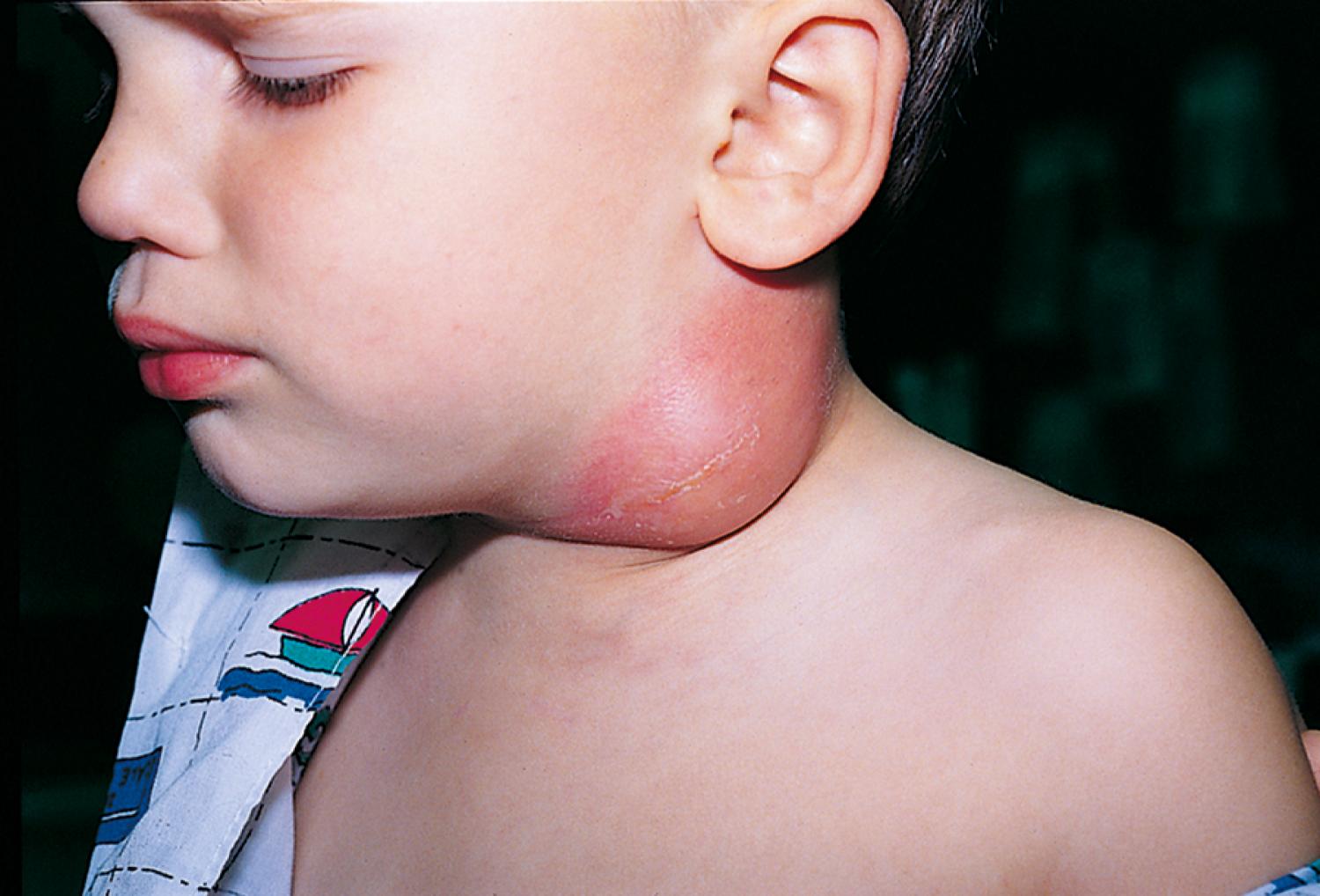
The differential diagnosis for chronic unilateral cervical lymphadenopathy (see Table 18.2 ) includes cat-scratch disease, atypical mycobacterial infection, and tuberculosis. Cat-scratch disease is a lymphocutaneous disorder and the most common cause of chronic nonbacterial lymphadenopathy in the developed world. It is caused by Bartonella henselae (see also Chapter 13 ). It usually develops as regional nodal enlargement 2 to 4 weeks after inoculation (typically from a kitten or dog but can be secondary to other animals as well). The neck is the second most common site after the axilla. There may be a local reaction to the scratch followed by the evolution of lymphadenopathy, which may persist for several months. Typically, there is one enlarged node in the chain, and it may be tender and firm. The disease is usually self-limited, but on occasion these nodes become suppurative and fluctuant and require drainage. The diagnosis may be confirmed by serologic testing for the antigen or by polymerase chain reaction of nodal tissue.
Various clinical presentations can be seen with mycobacterial infections, including cervical adenopathy, pulmonary infection, and disseminated disease. The most common presentation is secondary to one of the organisms of the Mycobacterium avium-intracellulare-scrofulaceum (MAIS) complex, which consists of approximately 15 organisms. These mycobacterial organisms typically produce localized cervical lymphadenopathy in the younger child. In contrast, Mycobacterial tuberculosis usually presents with pulmonary infection and only rarely presents with lymphadenopathy (typically supraclavicular). Atypical mycobacterial infection usually involves the submandibular, submaxillary, or preauricular lymph nodal regions ( Fig. 18.2 ). Large, firm, immobile, and nontender lymph nodes may arise after inoculation (typically from the mucous membranes of the pharynx). These may undergo spontaneous breakdown and drainage in up to 50% of cases with sinus formation in up to 10%. Incision and drainage of these nodes may lead to chronically draining sinuses. Complete resection of the node and any sinus tracts is usually curative. Children will either have a negative or doubtful purified protein derivative (PPD) test. Antimycobacterial therapy is not indicated in most cases of MAIS infection. Cervical adenitis secondary to Mycobacterium tuberculosis infection is usually a manifestation of intrathoracic disease and requires aggressive antimycobacterial drug therapy. Surgery is usually unnecessary in M. tuberculosis and should be avoided because of the risk of developing chronically draining sinuses. Surgery is limited to an excisional biopsy in rare situations where the diagnosis cannot be made by other means.
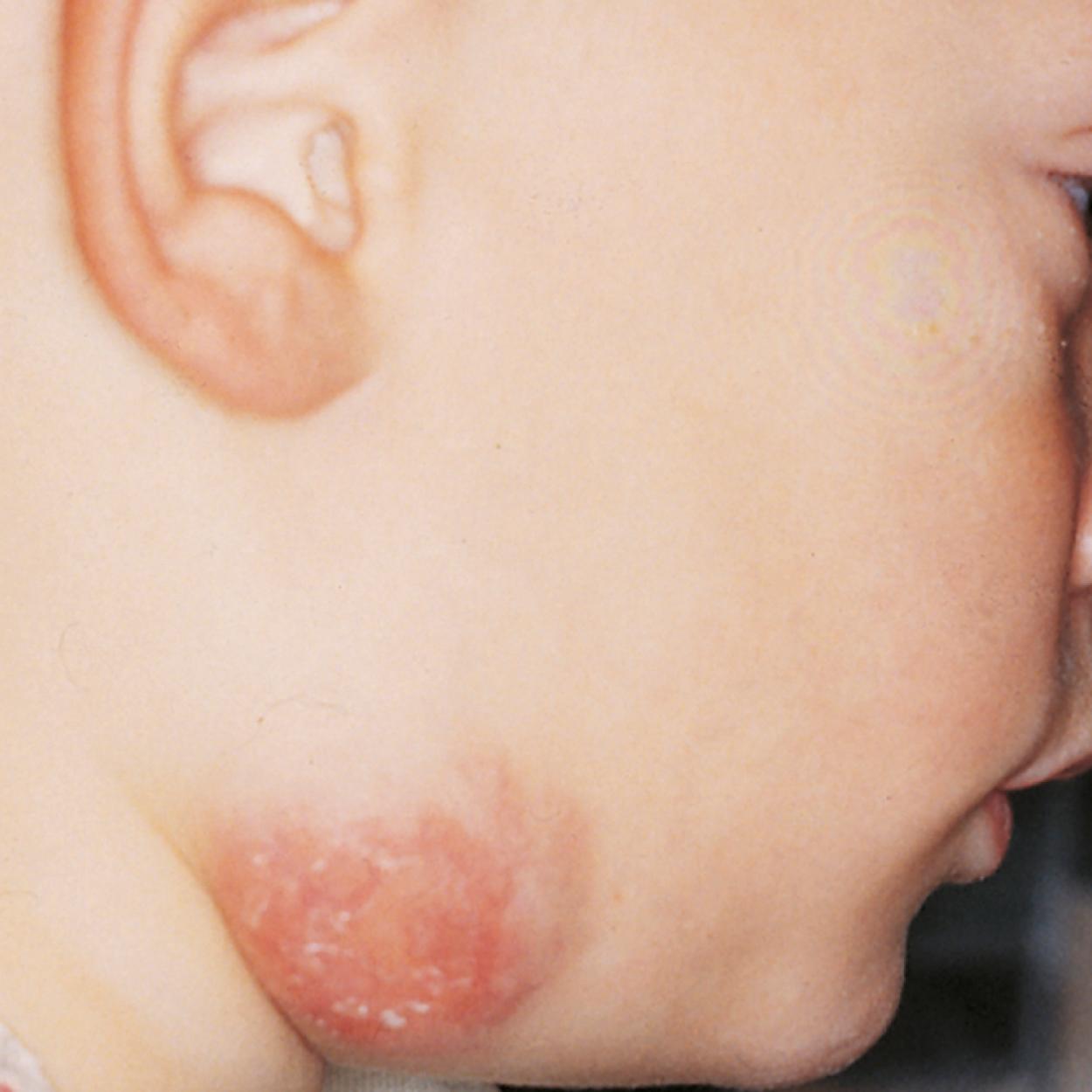
Lymphoma may present as painless cervical adenopathy. The absence of antecedent upper respiratory or cutaneous infections, the persistence of lymphadenopathy beyond 6 weeks, lack of response to treatment with antibiotics, size greater than 2 cm, and firm consistency should raise concern for malignancy. Although cervical adenopathy is more common in Hodgkin disease, non-Hodgkin lymphoma may also present with a cervical mass ( Fig. 18.3 ). The age of the patient may also be a clue as to the diagnosis, as well as the presence of associated symptoms, such as fever or night sweats. Excisional or, if needed, incisional biopsy is diagnostic and mandated when these criteria are met. Prior to proceeding with the biopsy, it is critical to determine respiratory status and review a chest x-ray to determine if there is bulky mediastinal disease as a component of the lymphoma. Significant mediastinal disease may result in respiratory collapse with anesthetic induction for the biopsy. Other primary malignancies such as neuroblastoma and rhabdomyosarcoma may present as lateral neck masses. Secondary metastasis from intraabdominal or head and neck tumors may also occur.
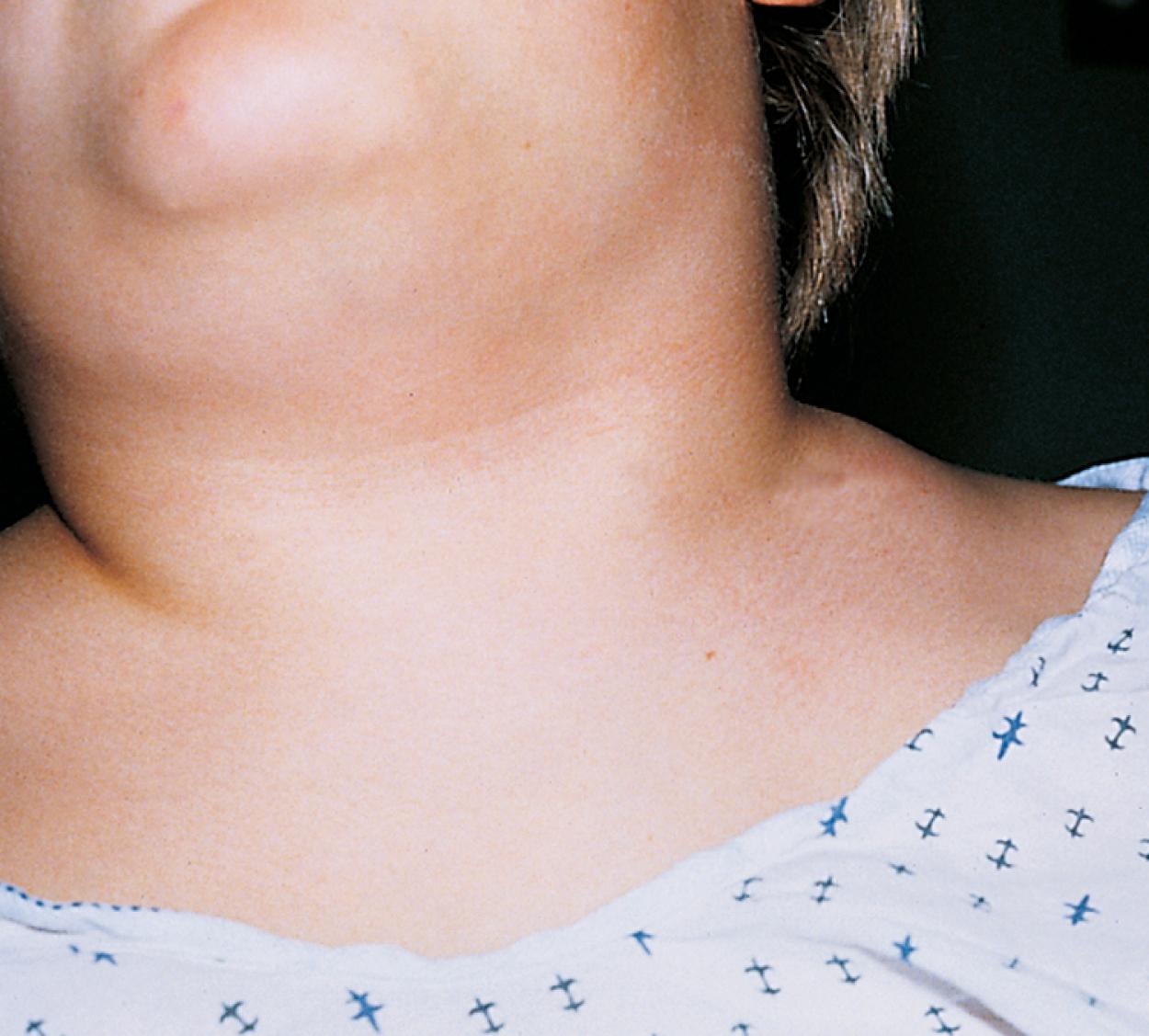
The differential diagnosis for midline neck masses includes thyroglossal duct remnants, dermoid cysts, and lymphadenopathy. During fetal development, the thyroid gland is derived from endoderm that originates at the base of the tongue (foramen cecum) and descends through the hyoid bone until it reaches its final position at the base of the neck ( Fig. 18.4 ). Failure of regression of the thyroglossal duct may lead to cyst formation. A cyst may be located anywhere along the thyroglossal duct. Two-thirds of cysts are near the hyoid bone. They are typically in the midline, smooth, soft, and nontender. On physical examination, the mass typically moves cephalad when the child sticks their tongue out. These lesions can typically be identified by history and physical exam alone. They are quite prone to infectious complications and require surgical excision. This excision requires resection of the midportion of the hyoid bone and ligation of the tract leading to the foramen cecum (Sistrunk procedure) to prevent future recurrence ( Fig. 18.5 ). One should attempt to identify the thyroid gland because 1% to 2% of the time the thyroglossal duct cyst may actually represent a lingual thyroid and removal will remove the entire thyroid tissue resulting in hypothyroidism.

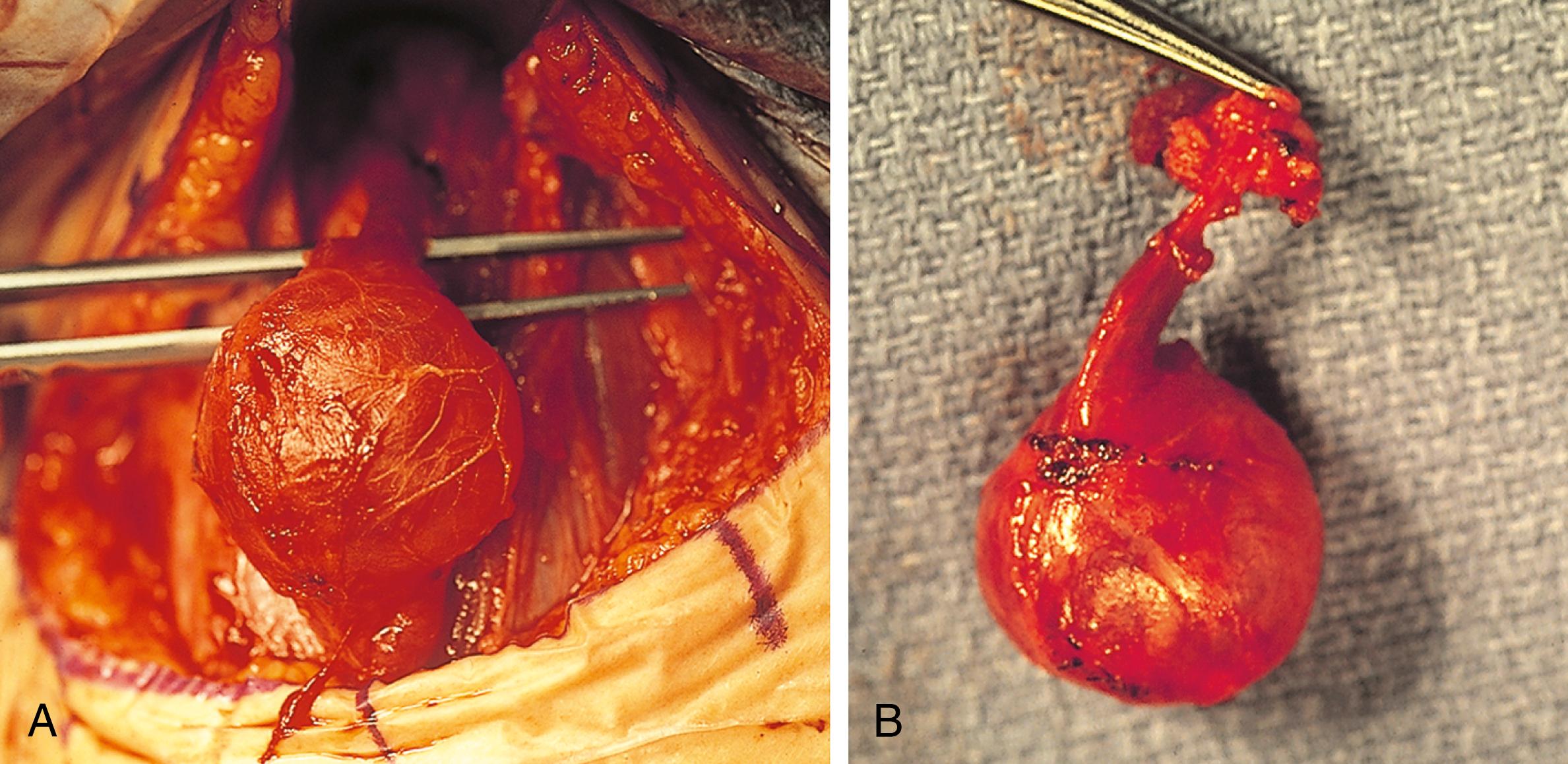
Thyroid nodules are uncommon in the pediatric population ( Fig. 18.6 ). However, as compared to adults, there is a greater incidence of malignancy within these lesions, with cancer rates of up to 25% as compared to only 5% to 10% in adults. There is also evidence to suggest that the incidence of thyroid cancer has increased among children over the past few decades. Although some of this increase can likely be attributed to enhanced imaging and diagnostic techniques, multiple studies would suggest a true change in incidence over time. Therefore, thorough evaluation and management of these lesions is critical to a favorable outcome. Thyroid cancer represents 2% to 3% of childhood malignancies. Malignant thyroid nodules typically present as anterior neck masses that move with the thyroid upon swallowing. However, many are detected incidentally with imaging for other reasons, i.e. lymphadenopathy or traumatic injury. Histologically, they can be divided into differentiated (follicular and papillary) and medullary subtypes. Papillary thyroid cancer accounts for over 90% of malignant lesions in childhood. Survival for tumors with differentiated histology is greater than 95%. In general, clinical findings are unreliable in distinguishing benign from malignant disease. Workup should begin with a thyroid ultrasound when a nodule is suspected. The Thyroid Imaging Reporting and Data System (TI-RADS) was developed to standardize the interpretation of thyroid ultrasound, stratifying lesions by the presence or absence of high-risk features in the categories of composition, echogenicity, shape, margin, and echogenic foci. According to the American Thyroid Association (ATA) Guidelines for the management of pediatric thyroid nodules and differentiated thyroid cancer published in 2015, high-risk or concerning lesions should undergo ultrasound-guided fine needle aspiration. Cytopathology findings are then categorized according to the Bethesda System for Reporting Thyroid Cytopathology. Typically, children with confirmed thyroid cancer are treated with total thyroidectomy +/− lymph node dissection, however data from adult studies would suggest that some smaller, more indolent lesions may be treated with lobectomy alone. The traditional approach to indeterminate lesions has been diagnostic lobectomy, with a completion thyroidectomy reserved for cases of cancer in children. However, in recent years mutational analysis via molecular testing (MT) has become a mainstay of the evaluation of thyroid nodules in adults. Anecdotally, MT has been used to stratify cancer risk and guide therapy for thyroid nodules in children, however data are currently lacking. It is likely that the need for diagnostic lobectomy and more aggressive surgery for thyroid cancer will decrease in the future without negatively impacting cancer-related outcomes.
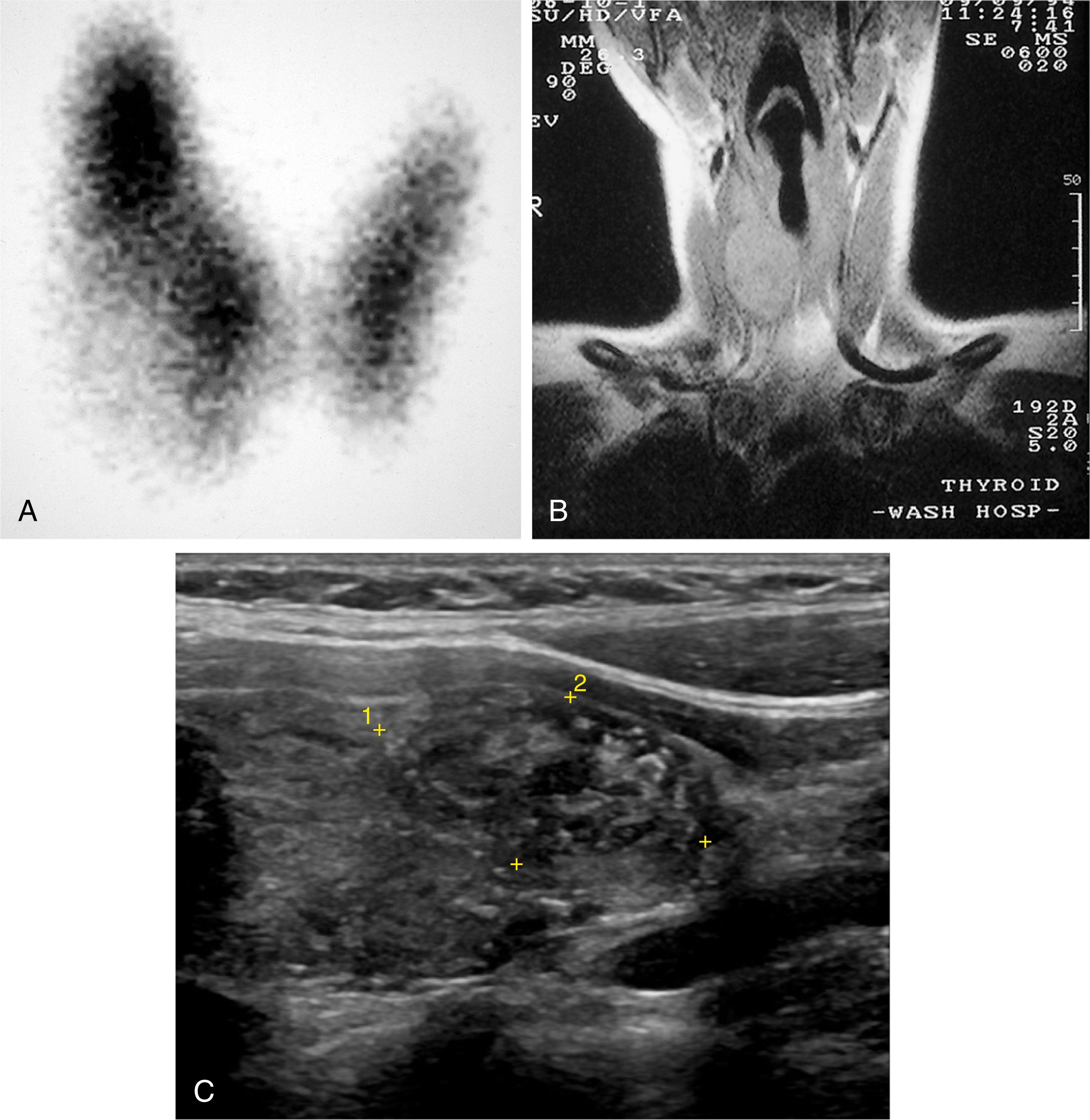
Branchial cleft anomalies give rise to cysts and sinuses in the lateral triangle of the neck. Second branchial cleft anomalies are the most common and typically present as an opening along the lower anterior border of the sternocleidomastoid muscle (SCM). The sinuses develop from embryologic remnants and have their origin in the tonsillar fossa and may travel between the carotid sheath to exit along the border of the SCM ( Fig. 18.7 ). Secondary infection of these lesions is common. Ideally, if they are infected, the infection should be treated prior to excision in order to facilitate a complete excision and reduce recurrence rates. Excision of the tract to the site of origin in the peritonsillar region limits recurrence. Other branchial cleft arch and cleft anomalies are much less common.
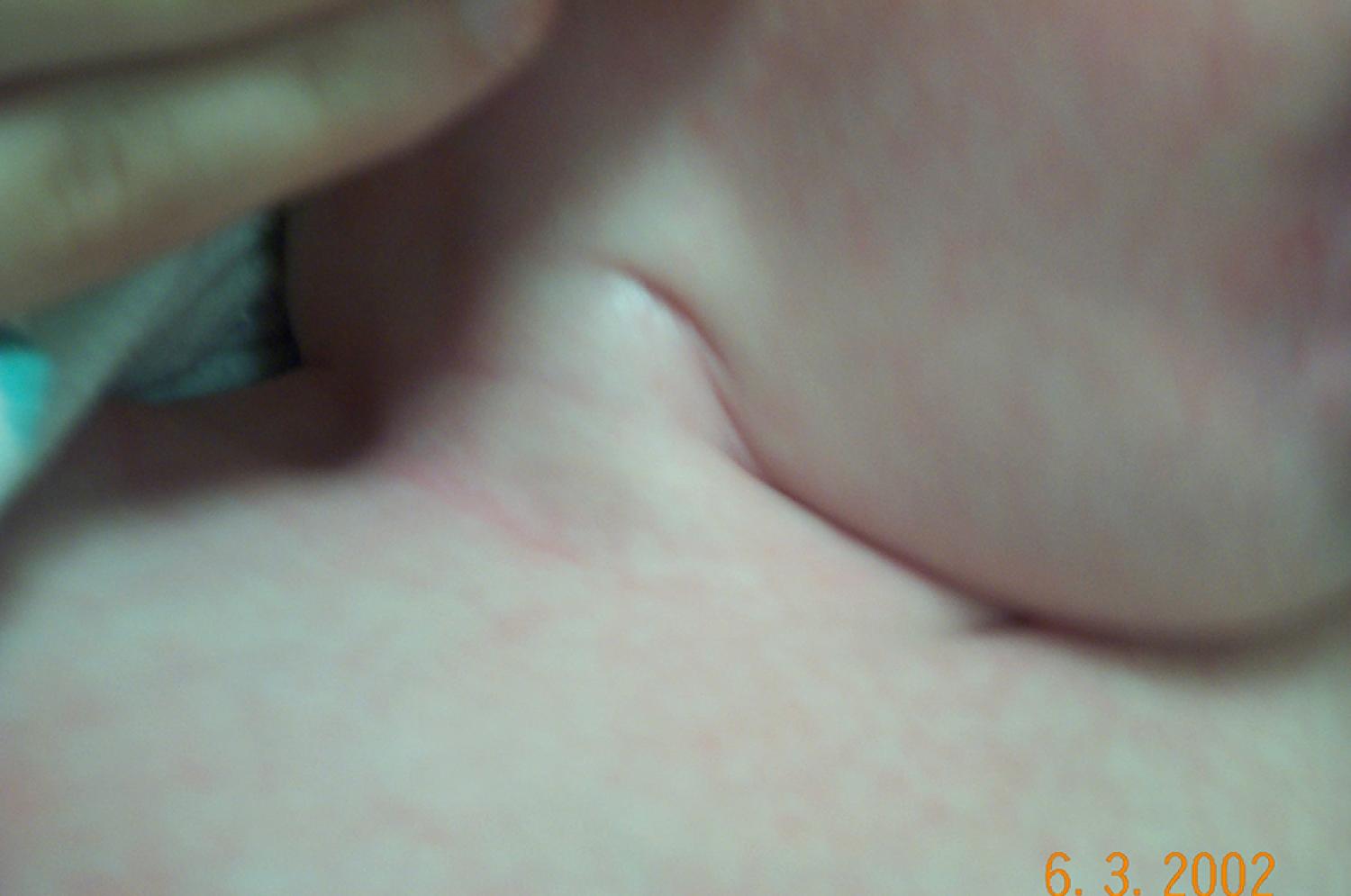
Fibromatosis coli, or fibrous dysplasia of the SCM, commonly is seen in infants and young children. These children present with a mass in the lower neck with tilting of the head and face to the side of the lesion ( Fig. 18.8 ). Parents most often bring their infants in because they are concerned about the possibility of a malignant tumor, whereas older children may present with hemifacial hypoplasia and asymmetry. Early recognition of this condition in infancy and the institution of daily physical therapy usually averts surgery and long-term cosmetic deformity ( Fig. 18.9 ). Plagiocephaly and facial asymmetry are the sequelae of untreated deformities (see Chapter 23 ).

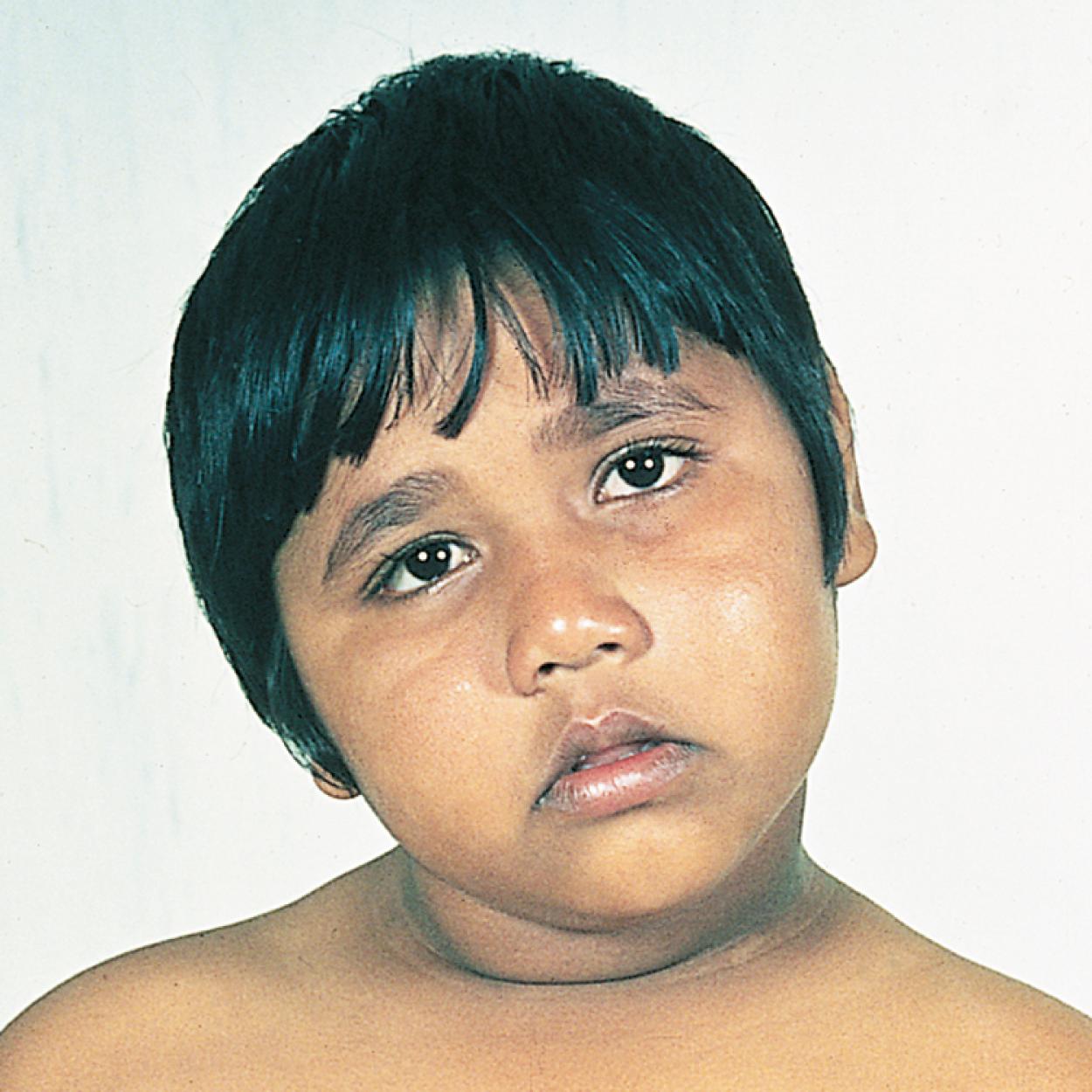
Hemangiomas are benign, congenital, vascular tumors that most frequently arise in the head and neck (60%). They are the most common benign neoplasm of infancy occurring in up to 10% of full-term infants and 25% of infants less than 1 kg. These lesions are raised above the skin level and are strawberry red in coloration. They may blanch with contact. Unlike vascular malformations (see Chapter 10 ), they typically grow out of proportion to the rest of the infant. Rapid growth and expansion may occur, in rare cases leading to platelet sequestration and coagulopathy, known as Kasabach-Merritt syndrome. Hemangiomas are typically marked by a proliferative phase, which may last 6 to 12 months followed by a phase of involution. Most hemangiomas have benign course and undergo spontaneous resolution over the first 5 years of life (see Chapter 10, Chapter 8 ). Surgical intervention is rarely necessary and should be reserved for those patients with airway compromise or periorbital involvement ( Fig. 18.10 ). If there is a concern that intervention may be required, referral to a vascular anomalies program can be discussed, including a full range of medical, minimally invasive, and open surgical options. Although these lesions will commonly undergo regression, this process must be monitored because up to 30% of lesions will leave significant deformities and a surgical scar must be weighed against the scar from involution.

Dermoid and epidermoid cysts are congenital lesions composed of sequestered hair and skin, and sebaceous material that occur in areas of embryonic fusion. Dermoid cysts—unlike epidermoid cysts—contain glandular structure. These lesions are most frequently in the head and neck but may arise in other midline sites, including the sacral, perineal, and sternal regions. Scalp dermoids are typically well circumscribed, firm, and fixed to underlying deep structures. They are most commonly noticed from birth to 3 months old. Midline scalp or back dermoids may be dumbbell shaped and have an intracranial or intraspinal component. They should always be evaluated with additional imaging (such as an MRI) before surgical intervention ( Fig. 18.11 ). They gradually grow due to the accumulation of sebum. If they rupture, they may cause granulomatous inflammation and infection. Excision is the treatment of choice.
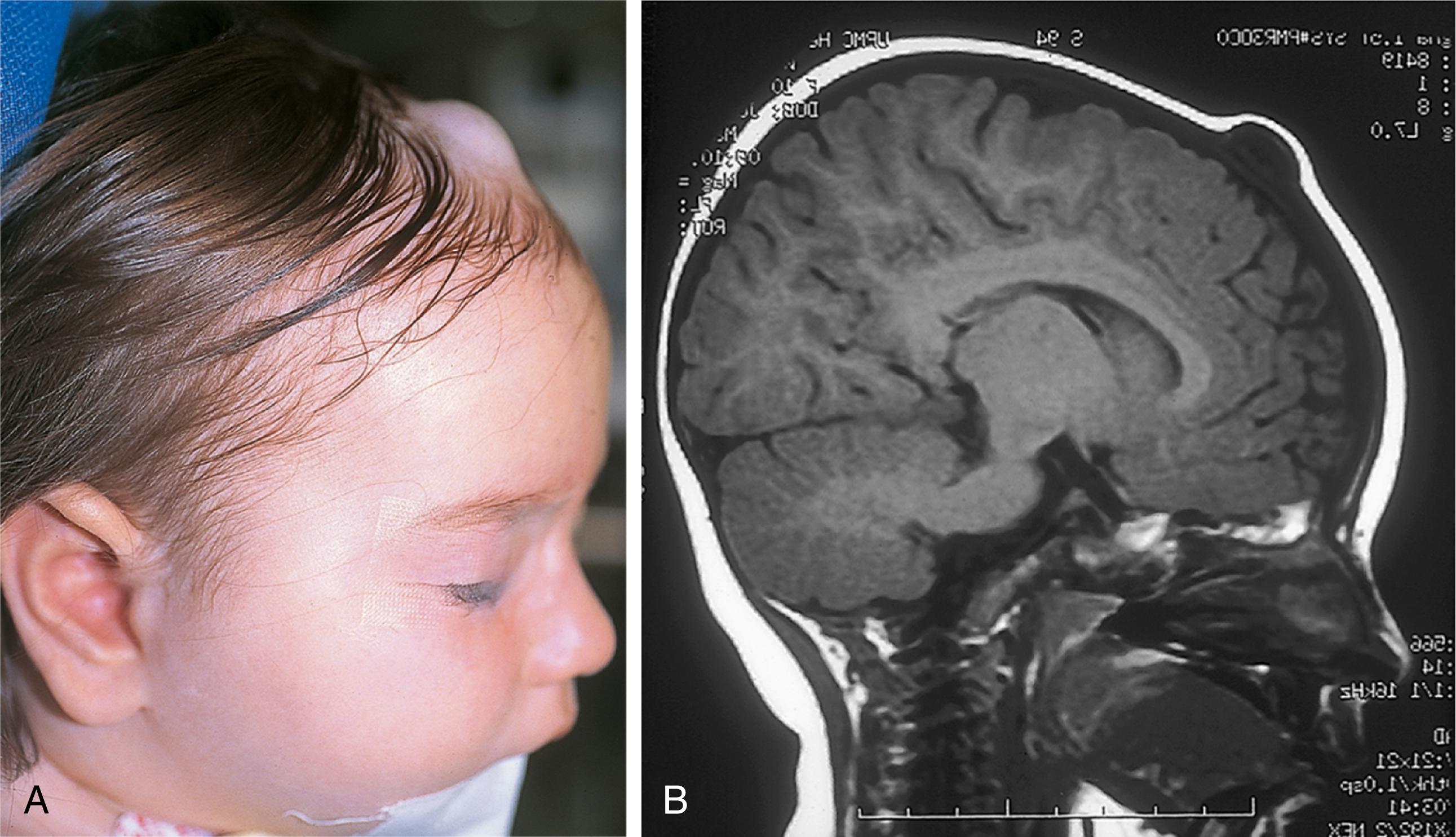
Several benign congenital structures may persist at birth, and they raise numerous management considerations. Preauricular skin tags are vestigial cartilaginous remnants that are removed primarily for cosmetic reasons. Preauricular pits or sinuses are ectodermal inclusion structures that are related to the embryologic formation of the ears (see Chapter 24 ). Although these lesions are prone to infectious complications, most are asymptomatic and excision is not needed unless there is a history of drainage and infection. Sinuses that drain are often connected to subcutaneous cysts. The incidence of these lesions is 0.1% to 0.9% in the United States and as high as 4% to 10% in Africa.
Various intraoral lesions may arise that have surgical significance due to their effect on swallowing, speech, and breathing. Tongue-tie (ankyloglossia inferior) occurs commonly in infancy, usually resolving spontaneously. The frenulum is usually a thin membranous structure that regresses with feeding. A persistent frenulum may impair speech and feeding. Frenulectomy, simple division of the frenulum, may be therapeutic but is rarely necessary. Similarly, ranulae may form from pseudocysts in the floor of the mouth ( Fig. 18.12 ). Some spontaneously resolve, whereas a few may become quite large and impair lingual mobility, feeding, speech, and most significantly breathing. Marsupialization or complete excision is curative.
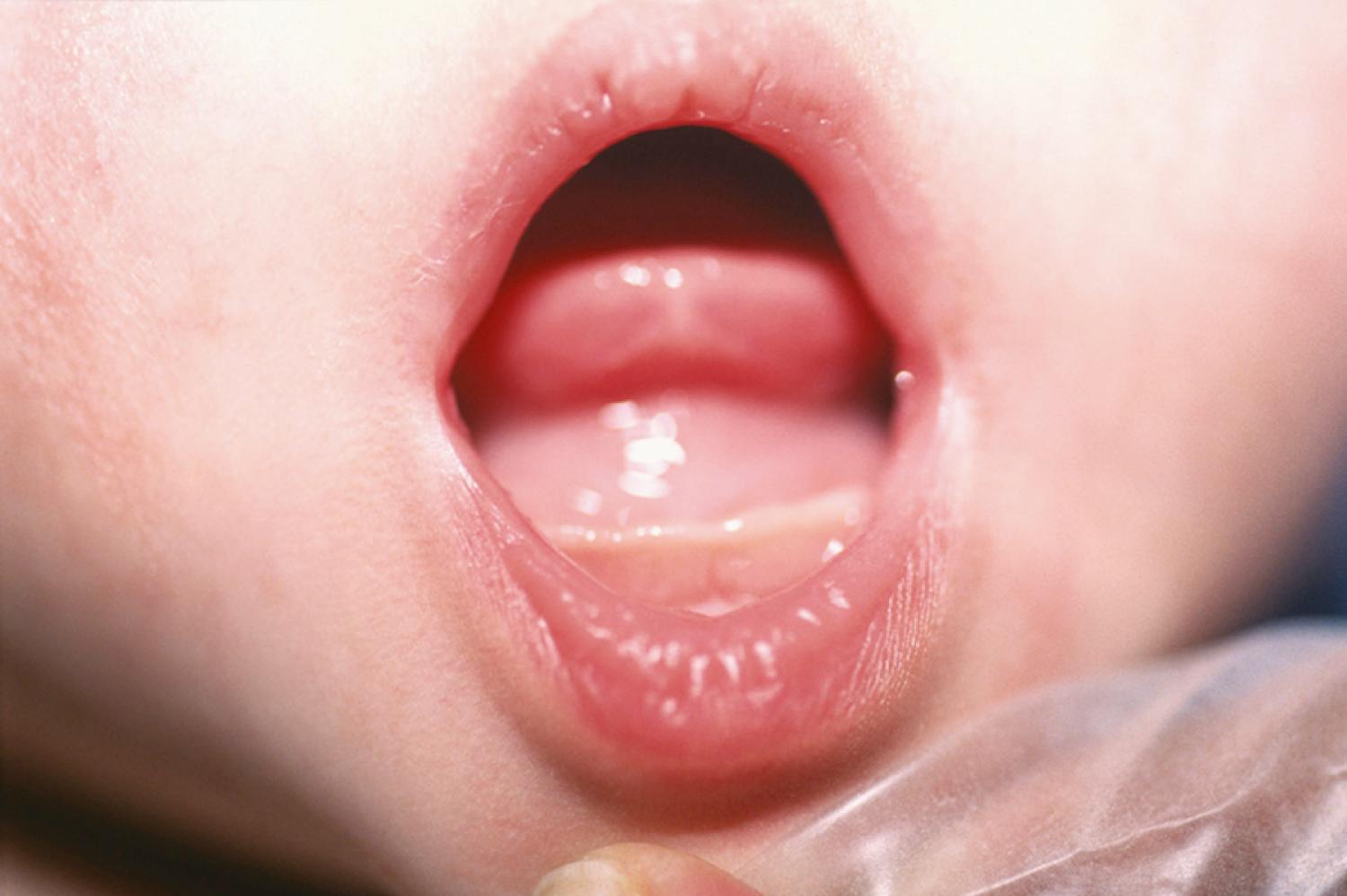
Lymphatic malformations (previously known as cystic hygromas or lymphangiomas ) of the floor of the mouth and neck may pose especially challenging management problems ( Fig. 18.13 ). These lesions may cause significant macroglossia that obstructs the airway requiring tracheostomy. Large neck lesions can also cause airway compromise. Historically these malformations were treated with surgical resection, often with high morbidity and recurrence due to an inability to completely resect these infiltrative lesions. Imaging is important in defining the extent and nature of the lesion, and in guiding the treatment of the malformation. Lesions that are composed of large cysts (macrocystic) respond better to drainage and sclerosis than lesions made up of tiny cysts (microcystic). The microcystic lesions can often act as a solid mass and make treatment especially challenging. The goals of treatment are to preserve function and cosmesis as much as possible. A combination of drainage, sclerosis, and surgical excision is often necessary in a multispecialty team, such as a vascular malformation clinic.
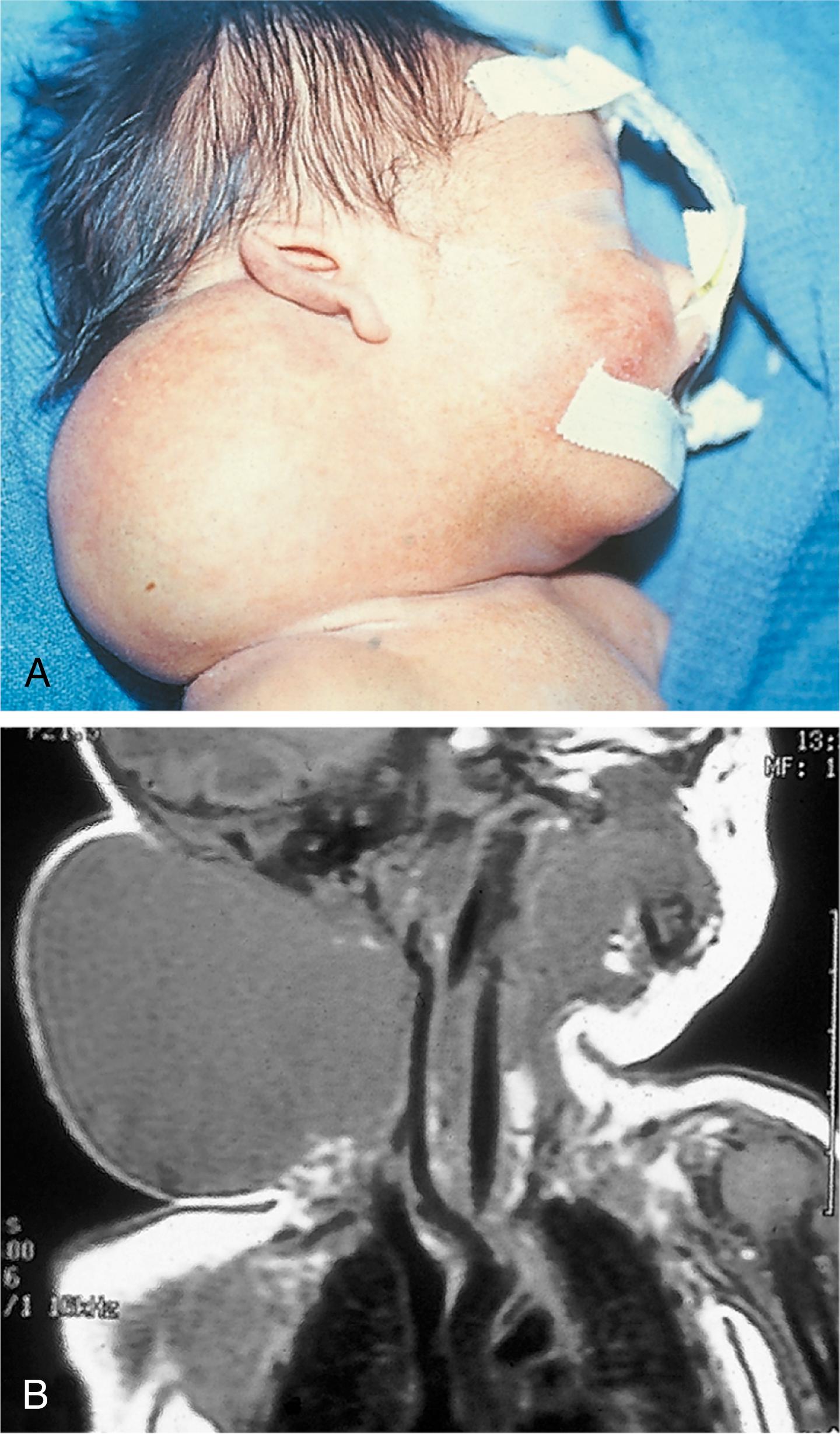
Neonatal respiratory distress is rarely due to surgical disease. However, symptoms such as severe dyspnea, hoarseness, or stridor may require urgent assessment by a surgeon and potentially surgical management. If plain radiographs rule out pneumothorax and pneumonia, the differential diagnosis of respiratory distress may include proximal obstructive airway lesions, intrathoracic masses, congenital lung lesions, or abdominal masses. A newborn who fails to respond to standard therapy for a presumed pulmonary disorder should be evaluated for a potential surgical etiology. The clinical evaluation of these patients should include both anteroposterior and lateral radiographs of the chest. Additional studies are directed based upon clinical and radiographic findings. These may include ultrasound to evaluate the diaphragm, chest wall, or abdomen; fluoroscopy to evaluate the esophagus and diaphragm ( Fig. 18.14 ); or cross-sectional imaging in the form of a CT scan or MRI. More invasive testing, such as upper airway or esophageal endoscopy, may be necessary to elucidate other surgical causes of respiratory distress. As always prior to any testing, it is important to treat and stabilize the patient prior to placing the unstable patient in a location or situation not suitable for a critical patient. The goal is first and foremost to establish and maintain a stable airway.

Airway obstruction may manifest clinically with stridor. Stridor is high-pitched monophonic breathing as a result of upper airway obstruction and airway narrowing (see Chapter 17, Chapter 24 ). The pattern of stridor can give the practitioner a clue as to the location of the pathology ( Table 18.3 ). Stridor can be inspiratory, expiratory, or biphasic. In general, inspiratory stridor is the result of obstruction in the extrathoracic region (glottis or supraglottic region), expiratory stridor results from intrathoracic obstruction, and biphasic stridor represents a fixed central airway obstruction.
| Nose | Pharynx | Larynx | Trachea | Distal Airway | |
|---|---|---|---|---|---|
| Pathology | Nasal anomalies | Tongue anomalies, craniofacial anomalies, pharyngeal masses | Laryngomalacia, laryngeal webs, atresia, and clefts, subglottic stenosis, vocal cord paralysis | Tracheal stenosis, vascular rings, tracheomalacia | Bronchogenic and enteric duplication cysts |
The newborn infant who is unable to nurse or has paroxysmal asphyxia (cyclic dyspnea) should undergo a thorough airway and cardiopulmonary evaluation. Lesions involving the upper airway create a characteristic “air hunger” that may progress to respiratory failure in the neonate. The respiratory difficulties are most marked during the expiratory phase of the cycle, which is when the airway tends to collapse around the lesion. These infants may be asymptomatic during the inspiratory component of the respiratory cycle, when the airway reaches its greatest diameter. The differential diagnoses for these symptoms should include choanal atresia, septal deformities, esophageal atresia, tracheoesophageal fistula, nasopharyngeal tumor, oropharyngeal masses, and foreign bodies.
The initial evaluation of infants with presumed airway obstruction should include the passage of a nasogastric tube. Signs of nasal obstruction suggest choanal atresia. Half of these patients may have other forms of associated craniofacial or remote congenital anomalies that require concurrent evaluation and management. Nasopharyngoscopy is diagnostic in most cases. It is critical that the oral airway be maintained, and the baby must be fed via gavage feedings until transpalatal repair. Pharyngeal obstruction may be caused by tongue abnormalities (macroglossia and glossoptosis) ( Fig. 18.15 ) and craniofacial anomalies ( Fig. 18.16 ). Tracheostomy may be necessary in order to protect the airway prior to surgical correction. Prone positioning may also provide a temporizing means of keeping the airway open. Pharyngeal masses may be another source of upper airway obstruction. These masses include dermoid cysts, pharyngeal duplications, hemangiomas, lymphatic or vascular malformations, and malignancies (neuroblastoma, rhabdomyosarcoma, or teratomas). Large cervical masses may induce airway compression or severe laryngotracheomalacia and cause dyspnea. Antenatal diagnosis of the lesion may predict a potential airway emergency at the time of delivery. The ex utero intrapartum treatment (EXIT) procedure, with a controlled cesarean section under a deep anesthetic with uterine relaxation, allows time to secure the newborn’s airway prior to umbilical cord division ( Fig. 18.17 ).
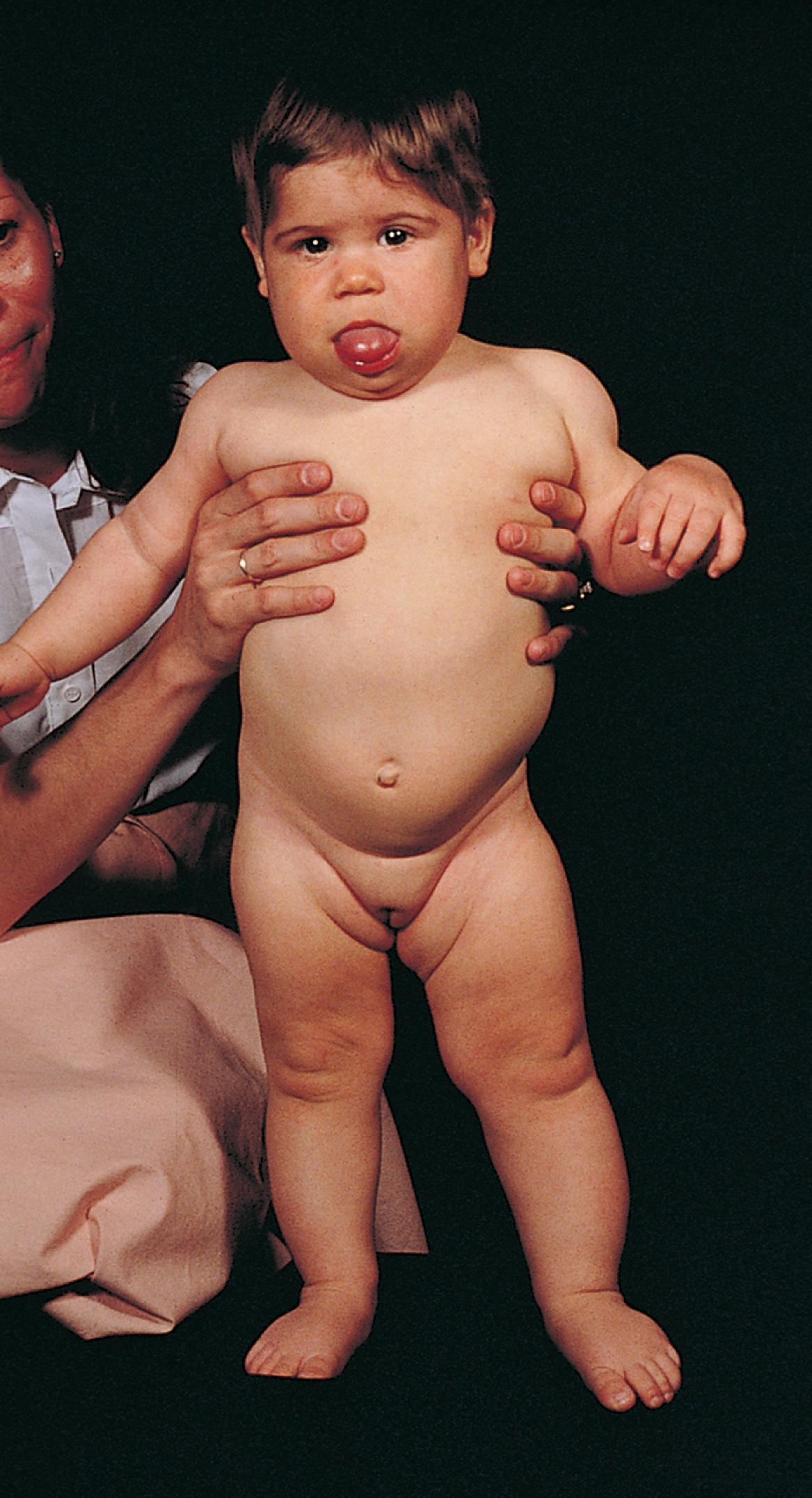
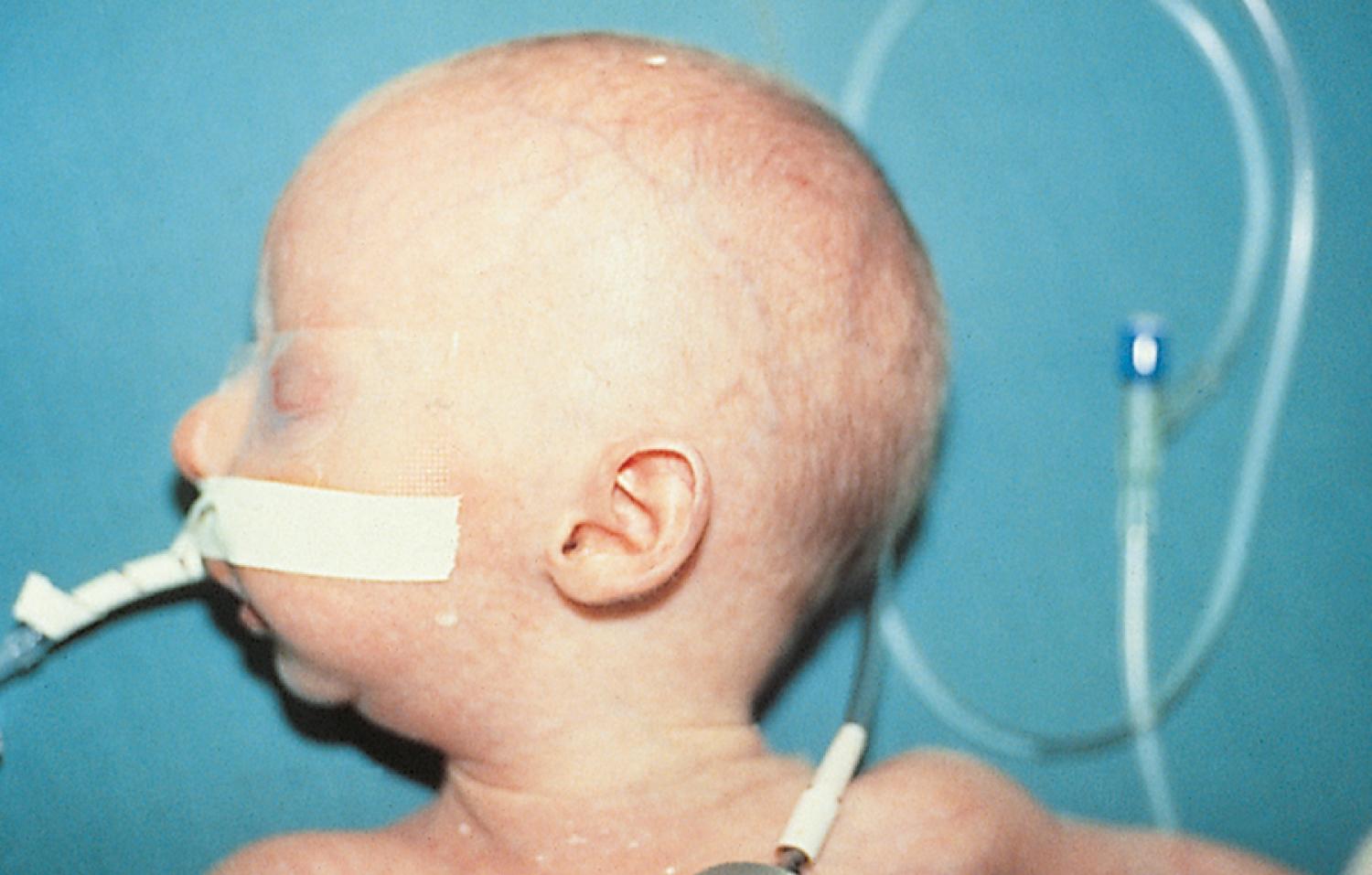
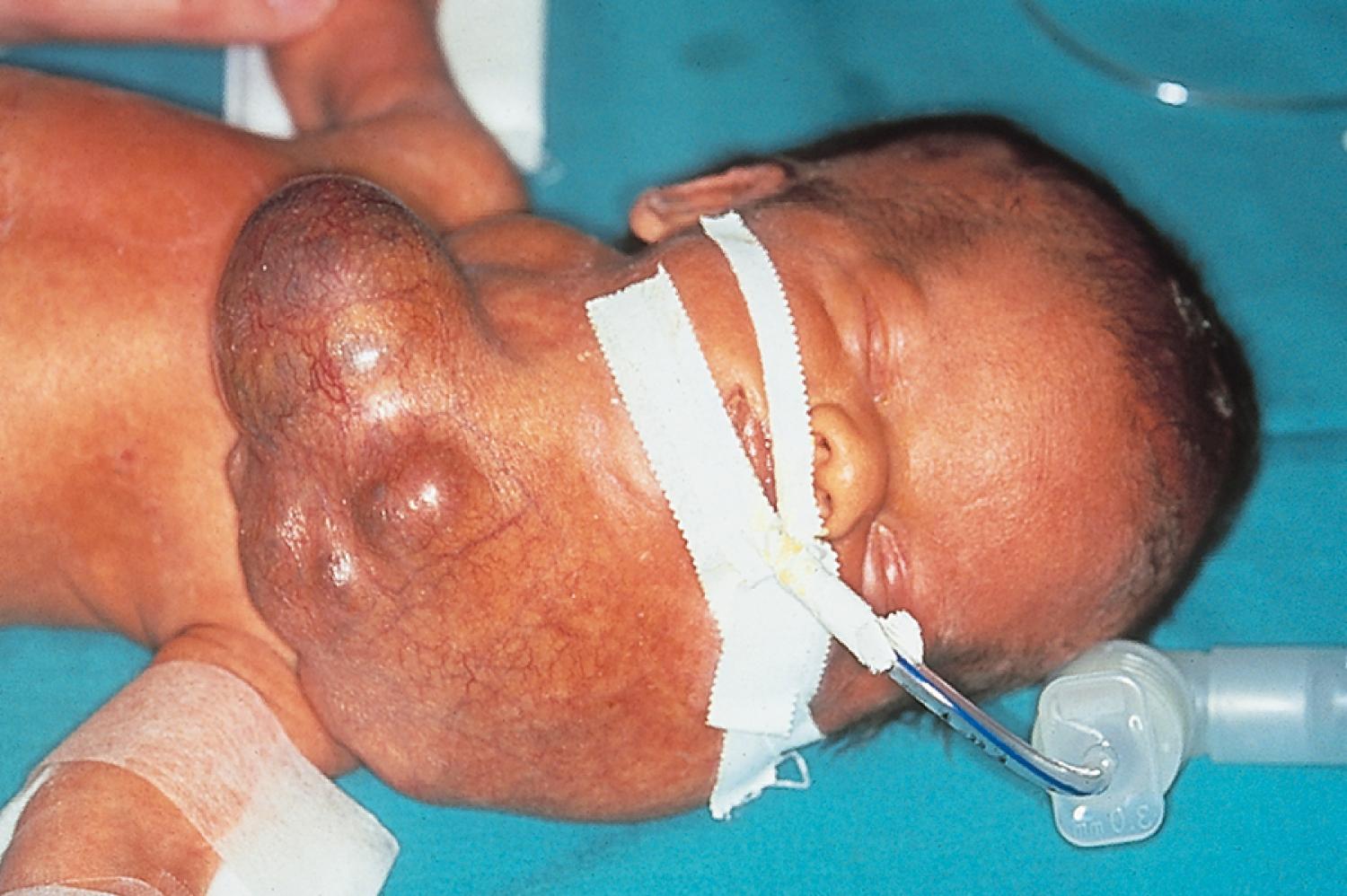
Laryngeal lesions distinctively present with hoarseness, faint crying, or complete aphonia in association with dyspnea. The differential diagnosis can be seen in Table 18.3 . Emergency tracheostomy may be necessary in these patients if the airway cannot be secured without a surgical intervention. A neonatal tracheostomy is a technically challenging procedure, and rarely needed.
Mediastinal masses are relatively uncommon in the pediatric population but can present at all ages. The limited space of the thoracic cavity predisposes normal structures to be compressed causing both respiratory and cardiovascular compromise. Lesions may be congenital, neoplastic, infectious, and inflammatory in nature. The mediastinum can be divided into three major compartments: the anterior (thymus, vessels, lymphoid structures, and nerves), middle (trachea, main stem bronchi, the heart and great vessels, and hilar lymph nodes), and posterior (aorta, esophagus, and the sympathetic nerve chain). The patient’s age and the mediastinal location provide the most critical insight into potential diagnoses ( Table 18.4 ).
| Anterior | Middle | Posterior | |
|---|---|---|---|
| Benign | Teratoma, normal or hyperplastic thymus, thymic cyst, intrathoracic goiter, lymphatic or vascular malformations | Lymphatic or vascular malformation, bronchogenic duplications and cysts, pericardial cysts | Enteric duplication cysts, ganglioneuroma |
| Malignant | Thymic tumor (rare), lymphoma | Lymphoma | Neuroblastoma |
Esophageal atresia with or without tracheoesophageal fistula represents one of the more common causes of esophageal obstruction in neonates with an incidence of 1 in 2500 to 3000 live births. The inability to pass a nasogastric tube into the stomach clarifies this diagnosis, while a chest x-ray with the nasogastric tube on gentle tension may shed light on the anatomy of the defect. The tube may also serve as a sump catheter to drain the proximal pouch. Infants may develop respiratory distress from several mechanisms. The proximal dilated pouch may cause airway obstruction, there may be aspiration of contents from the upper pouch, or there may be a direct communication or fistula between the trachea and the esophagus (Gross type B or D, Fig. 18.18 ). There may also be associated laryngotracheomalacia. Neonates with esophageal atresia characteristically have excessive salivation and coughing from pooling of secretion in the proximal pouch. Most patients are diagnosed by their inability to tolerate initial feedings. This presentation may be dramatic, with episodes of aspiration, coughing, gagging, and even periods of cyanosis. The most common type of esophageal atresia includes a blind ending proximal esophageal pouch and a distal tracheoesophageal fistula (type C, 85%). If possible, positive-pressure ventilation should be avoided in these infants because ventilation may contribute to loss of tidal volumes into the GI tract, increased gastric distention, and even perforation when associated with a downstream obstruction (i.e., duodenal atresia). Reflux of gastric contents into the airway with resultant pneumonitis and pneumonia can contribute to evolving respiratory distress ( Fig. 18.19 ). The second most common anatomical configuration is pure esophageal atresia (type A), which may be associated with findings of a dilated proximal pouch and the absence of intestinal gas on plain radiography and scaphoid abdomen ( Figs. 18.20 and 18.21 ). The third most common type is an isolated tracheoesophageal fistula without esophageal atresia (type E or “H type” fistula). These children are often diagnosed later in infancy or childhood with symptoms of persistent cough or recurrent pneumonias as their esophagus is in continuity. In general, these patients are stabilized while a workup of associated anomalies (i.e., VACTERL) can be completed prior to surgical intervention.
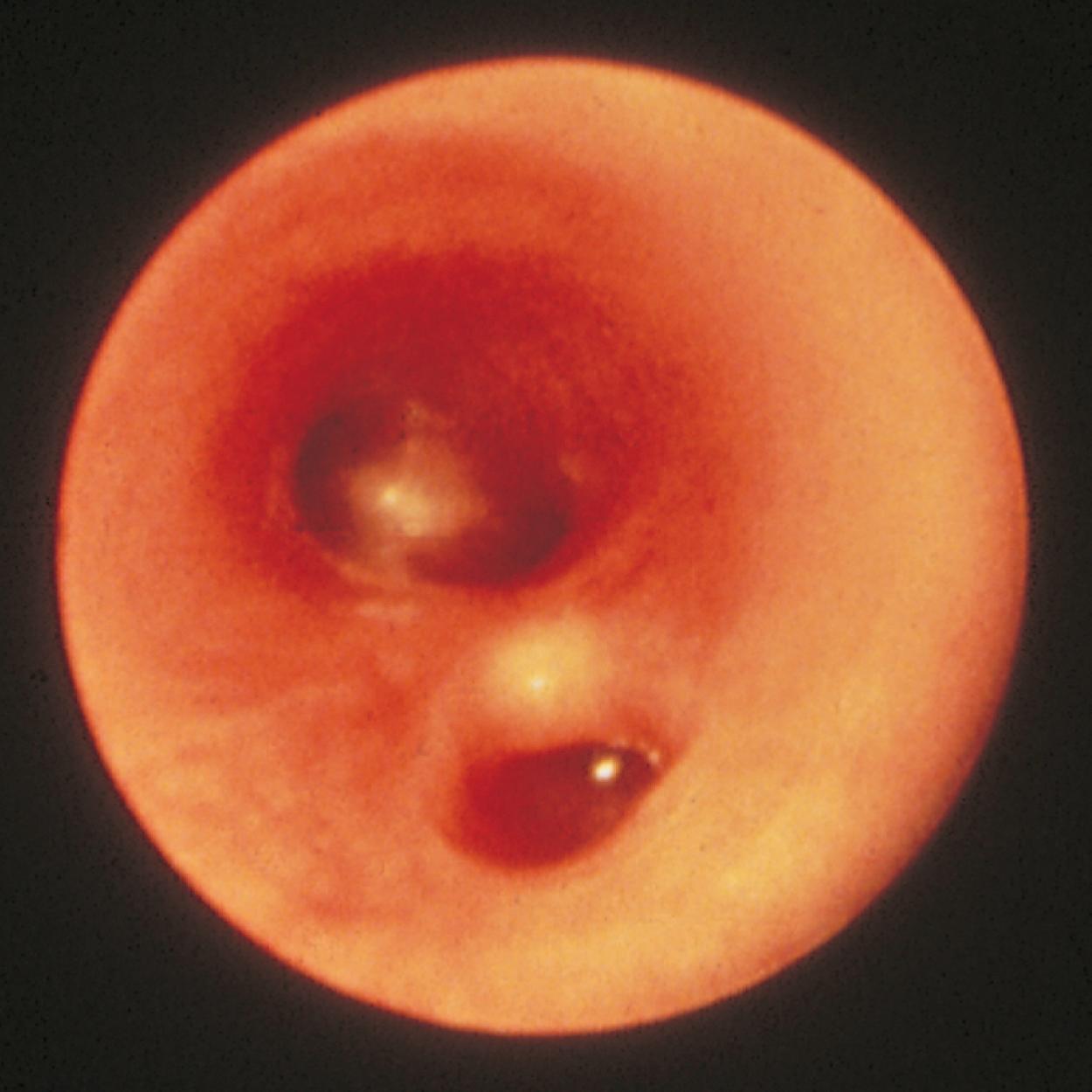
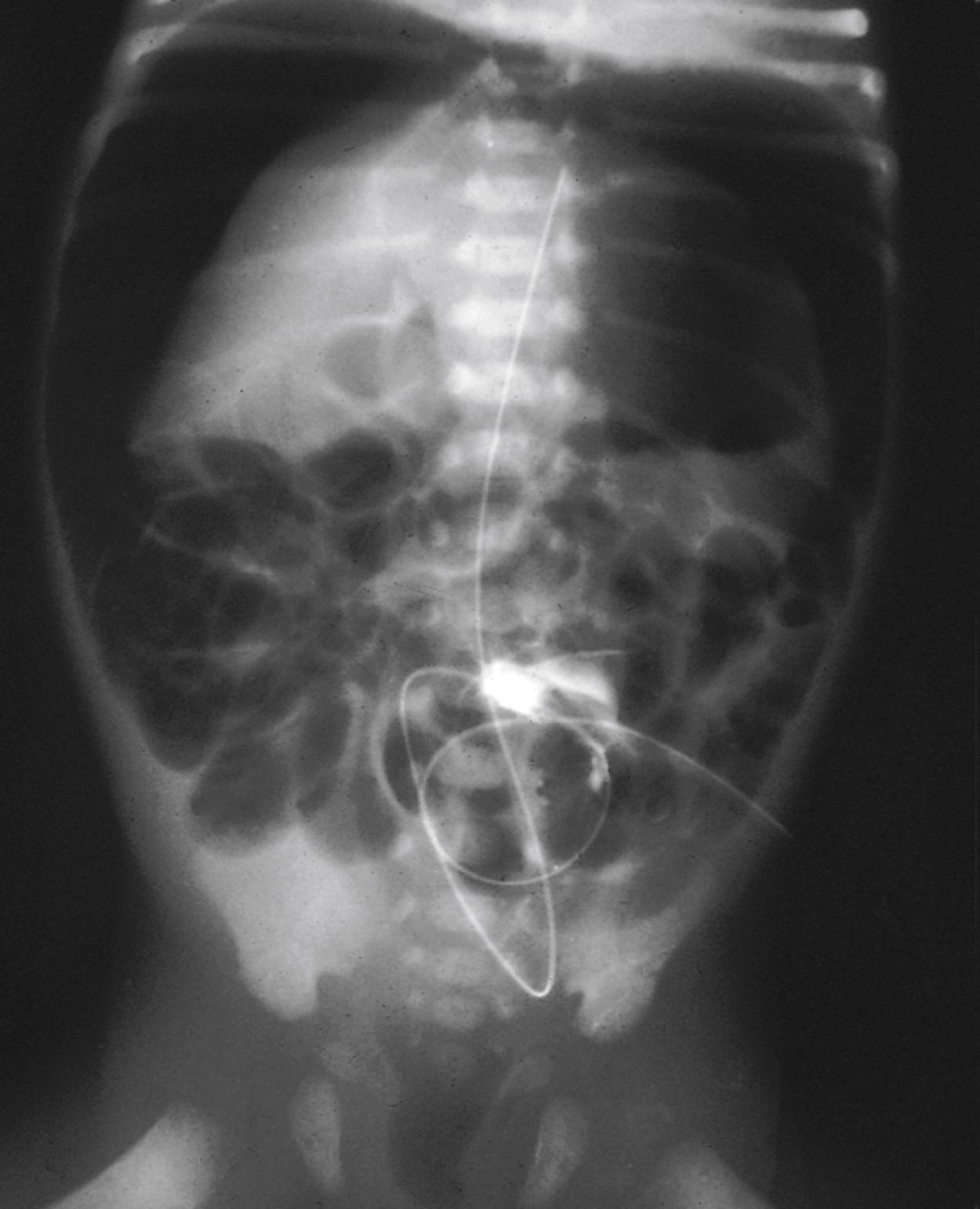
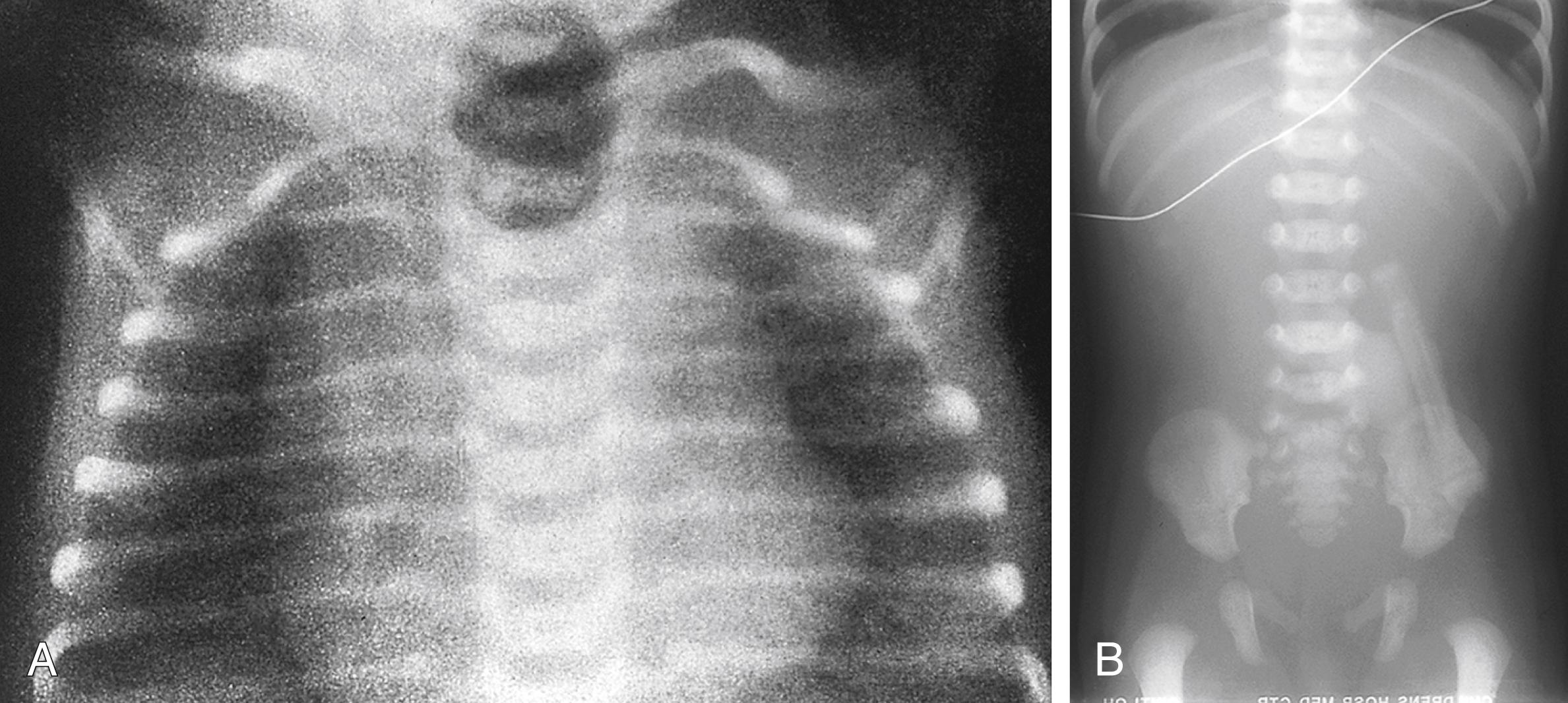
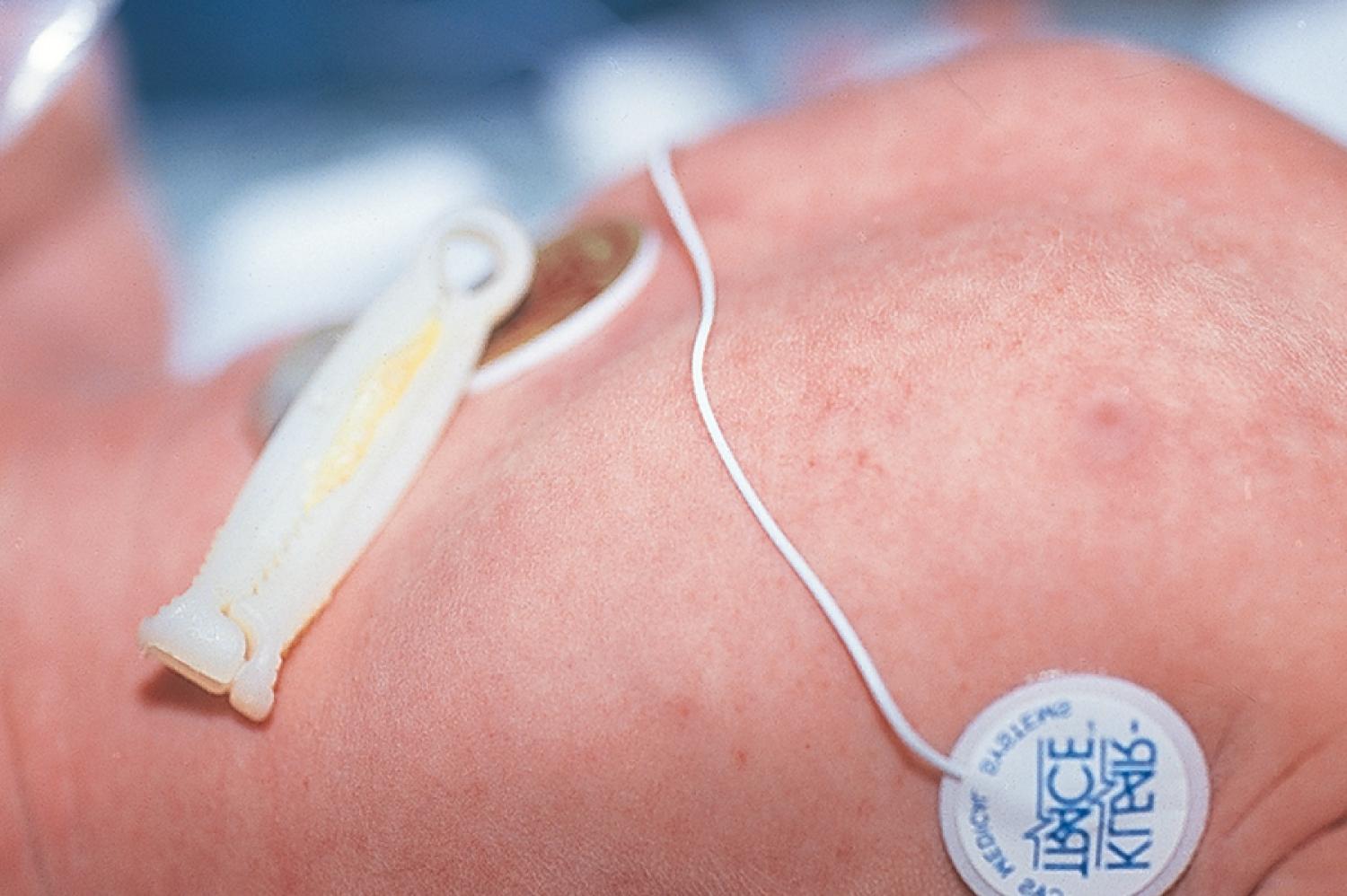
Congenital diaphragmatic hernia (CDH) is another cause of respiratory distress in newborns, with an incidence of 1 in every 4000 live births. Although esophageal atresia and tracheoesophageal fistula are generally not recognized antenatally, CDH is commonly diagnosed on antenatal ultrasound, allowing for prenatal counseling regarding the congenital anomaly and its treatment. Additional imaging using fetal MRI may also be used in order to define the anatomy and provide additional prognostic information. A variety of scoring indices have been developed to help identify patient risk of morbidity and mortality in order to provide sound antenatal counseling, plan for delivery, and logical decisions regarding resource utilization after birth. Defects may be posterolateral (Bochdalek; Fig. 18.22 ) or anterior central (Morgagni; Fig. 18.23 ). Bochdalek defects are the most common and found on the left side in 85% of infants. The exact etiology of the defect is unknown, however these infants generally present with associated pulmonary hypoplasia (bilateral), and resultant persistent pulmonary hypertension. This constellation is thought to derive from a field defect including the CDH, rather than simply resulting from herniation of abdominal viscera into the chest causing compression. Many of these infants have severe respiratory distress occurring shortly after umbilical cord division. On physical exam, there may be marked nasal flaring, displaced heart tones to the side opposite the hernia, ipsilateral absence of breath sounds with dullness to percussion due to the presence of abdominal viscera, and the appearance of a scaphoid abdomen. Plain films demonstrate intestinal loops within the hemithorax, and a nasogastric tube often may be seen within the intrathoracic stomach. The significant morbidity and mortality of CDH is due to the associated severe pulmonary hypoplasia and pulmonary hypertension (when this does not resolve). Disease may be further complicated by the presence of congenital heart disease, and significant cardiac defects in the setting of CDH are almost uniformly lethal. In most patients, pulmonary hypertension will improve in the days following delivery. Repair of the diaphragmatic hernia does not relieve or resolve pulmonary hypoplasia or hypertension, and, although necessary can be deferred until the neonate has stabilized. Despite advances in neonatology and the availability of extracorporeal membrane oxygenation (ECMO) support, the mortality rate with CDH is still approximately 40% to 50%. Morgagni defects account for less than 5% of all cases of CDH. They are often found incidentally on routine radiography for other reasons and are not associated with pulmonary hypoplasia. In rare instances, intestinal contents may become incarcerated in these relatively small hernia defects. Congenital pulmonary airway malformations (CPAMs) may be confused with CDHs on plain films and are usually distinguished by the tip of the nasogastric tube identifying the location of the gastric air bubble.
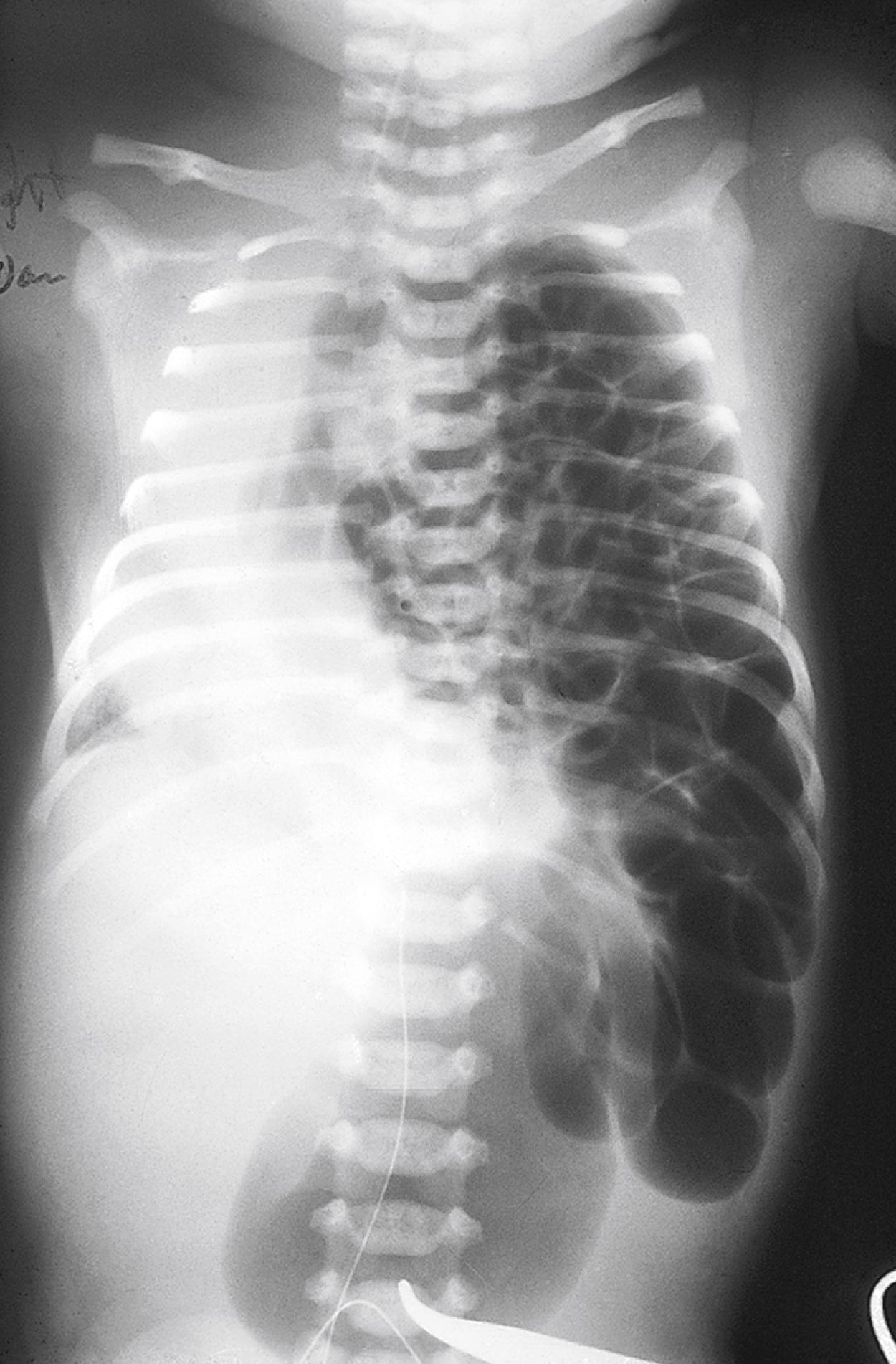
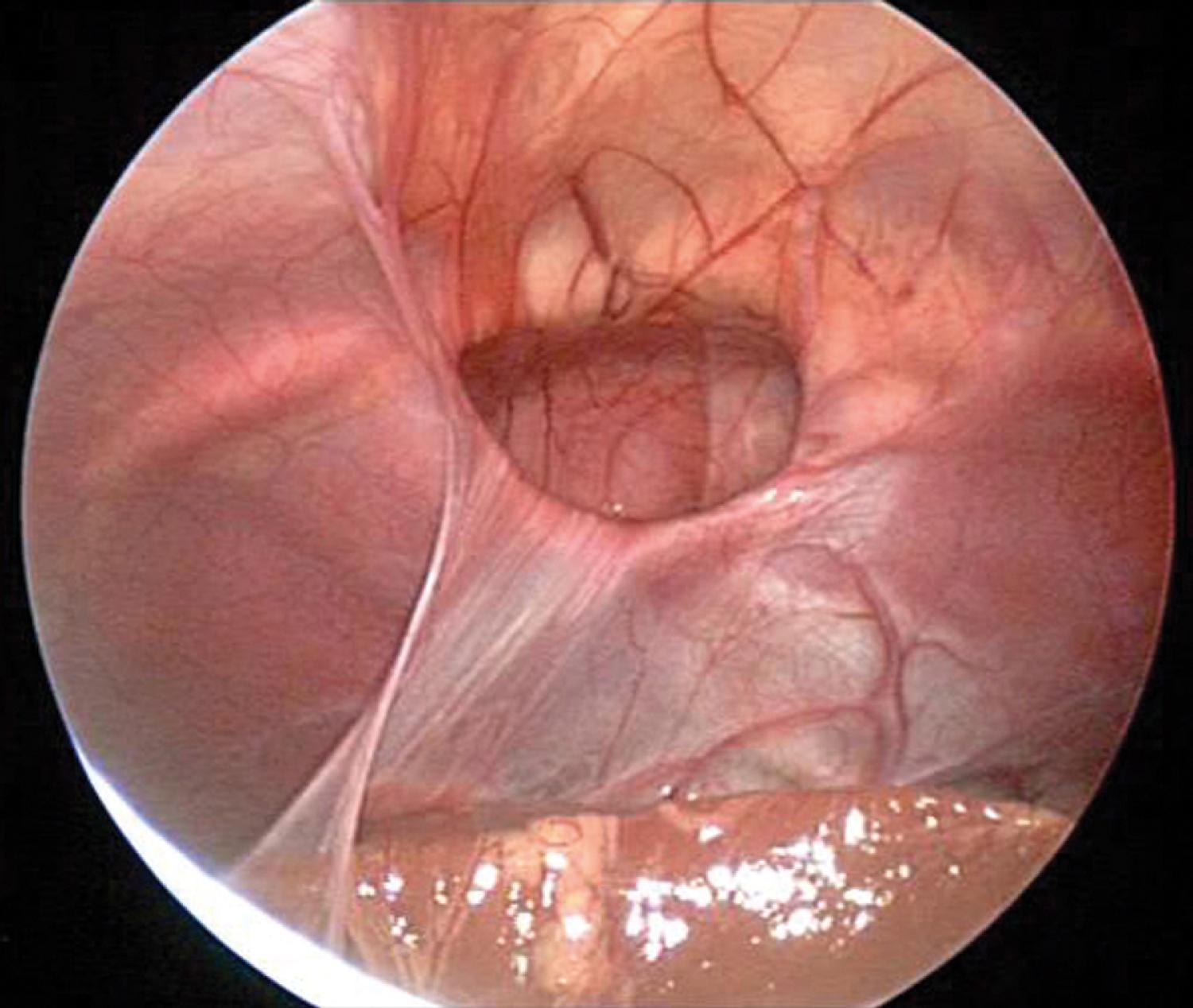
Congenital lung lesions may induce severe respiratory distress by direct compression on normal adjacent lung parenchyma, the airway, or adjacent vascular structures. Congenital cystic anomalies of the lung are the most common cause of respiratory distress in neonates and children requiring surgical intervention. These include lung lesions such as CPAMs, congenital lobar emphysema (CLE), pulmonary sequestrations, as well as bronchogenic cysts. Surgical intervention, when warranted, is safe and with the development of minimally invasive techniques is now associated with lower short- and long-term morbidity rates.
CPAMs, previously known as congenital cystic adenomatoid malformations (CCAMs), are the most common of the bronchopulmonary foregut malformations, accounting for up to 30% to 40% of all fetal lung lesions. In general, CPAMs are confined to a single lobe of the lung and the pathophysiology of cyst formation is largely unknown. Anatomically, they have a connection to the tracheobronchial tree and maintain a blood supply from the pulmonary circulation. However, alveoli are abnormally formed and in general do not provide normal gas exchange. These lesions have been traditionally divided into three categories (i.e., Stoker classification) based upon their size, shape, and pathologic appearance; however, this categorization has little clinical relevance. A more relevant classification uses gross anatomy of the lesion’s appearance on prenatal ultrasound. This classification divides CPAMs into macrocystic (single or multiple cysts measuring at least 5 mm in diameter) ( Fig. 18.24 ) and microcystic (appearing almost solid on prenatal ultrasound) lesions. Prenatally, lesions may demonstrate a predictable pattern with maximal growth between 20 and 28 weeks. After 28 weeks most CPAMs plateau or may even regress in size. This is particularly true with microcystic lesions. However, some large macrocystic lesions may undergo periods of rapid growth, resulting in fetal hydrops. Antenatal drainage procedures may play a role in these patients. The majority of patients with persistent lesions are asymptomatic at birth, but a minority of neonates may present with respiratory distress secondary to compression of normal lung and mediastinum by large lesions. Although there is still some controversy regarding treatment of asymptomatic lesions, it is typically recommended that they be resected due to the risk of repeated infections and a theoretical concern for malignant degeneration over time. In an otherwise healthy child, workup generally consists of a CXR at birth and a CT scan of the chest at 3 to 6 months for surgical planning.
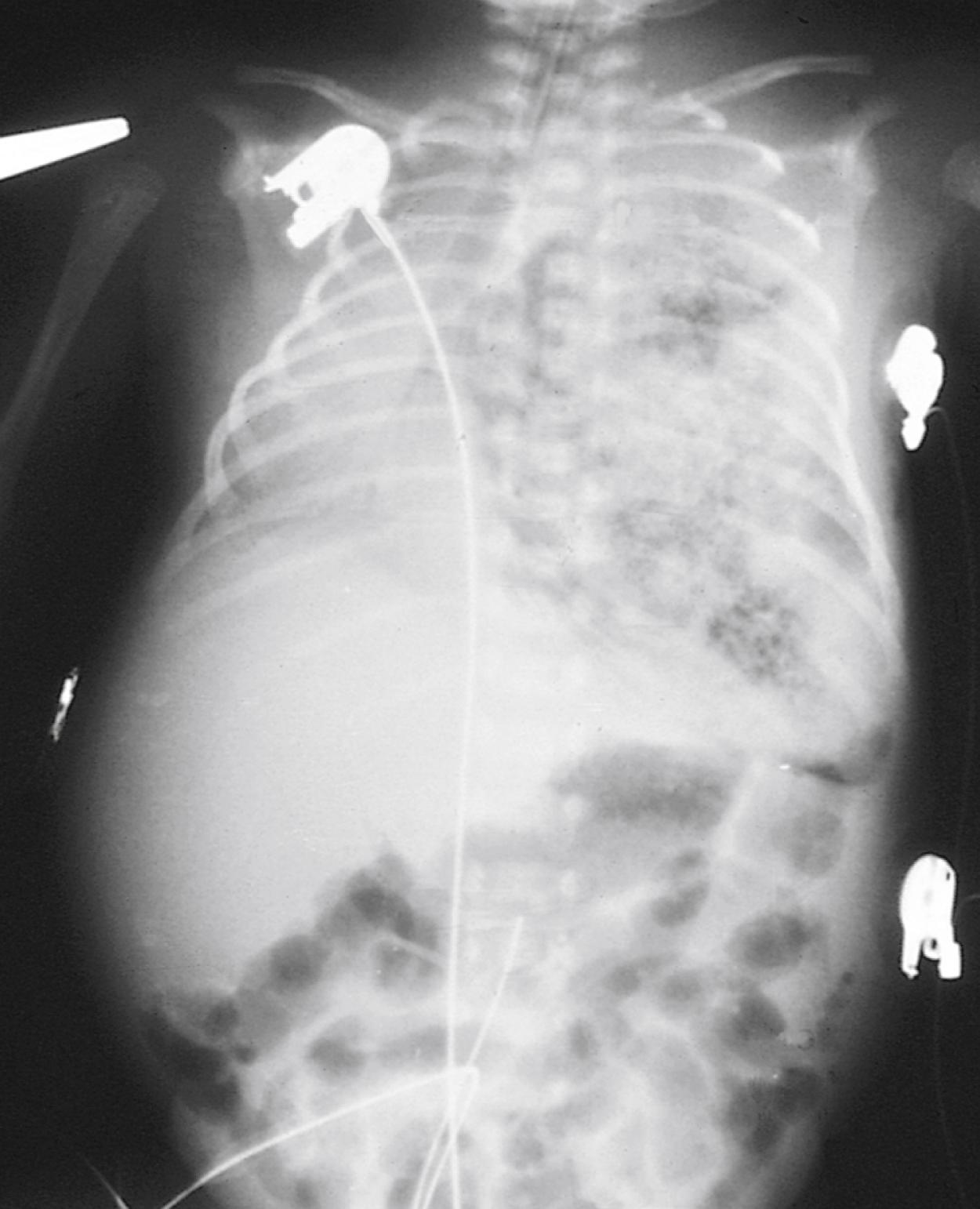
CLE is marked by abnormal hyperinflation of histologically normal lung. Hyperinflation results from a segment of poorly developed or absent cartilage in the tracheobronchial tree. The left upper lobe is the most commonly affected followed by the right middle lobe and right upper lobe ( Fig. 18.25 ). Many of these patients present with symptomatic lesions in the first few weeks of life, whereas others have a more indolent course. Symptoms may include respiratory distress or poor feeding and weight gain due to fatigue. Plain film demonstrates lobar hyperinflation, possible mediastinal shift, and flattening of the diaphragm. These patients can present as a respiratory emergency with mediastinal shift (similar to a tension pneumothorax) and require emergent thoracotomy followed by resection. The treatment of asymptomatic CLE lesions is even more controversial. When the diagnosis is not in doubt, several studies have suggested that observation is appropriate.
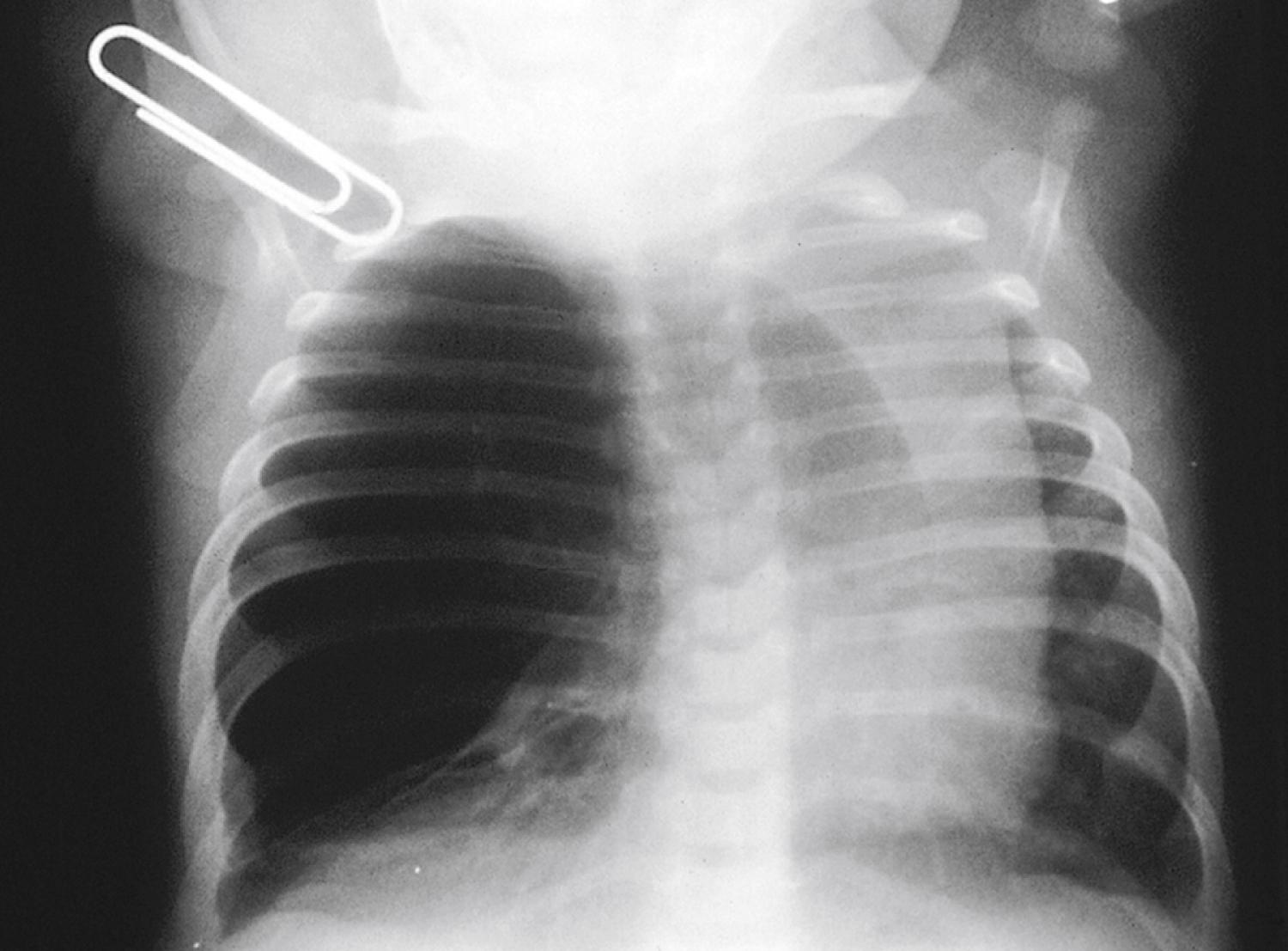
Pulmonary sequestrations are abnormal, nonfunctioning pulmonary parenchymal tissue lesions that lack a direct communication with the tracheobronchial tree. These lesions receive their blood supply from the systemic circulation. They may arise within the pulmonary parenchyma (intralobar; Fig. 18.26 ) or separately from lung tissue within its own pleural investment (extralobar; Fig. 18.27 ). Intralobar sequestrations may be identified on prenatal ultrasound and their presence confirmed by postnatal CT. However, they may also present later in life with repeated infections within the lobe and even abscess formation. They generally require resection after adequate treatment with antibiotics. Extralobar sequestrations may be intrathoracic or intraabdominal in location and can be associated with CDHs (up to 5% of infants with CDH also have incidental sequestration). They may be identified either on prenatal ultrasound or found incidentally. In general, these are resected due to concern for recurrent infections.
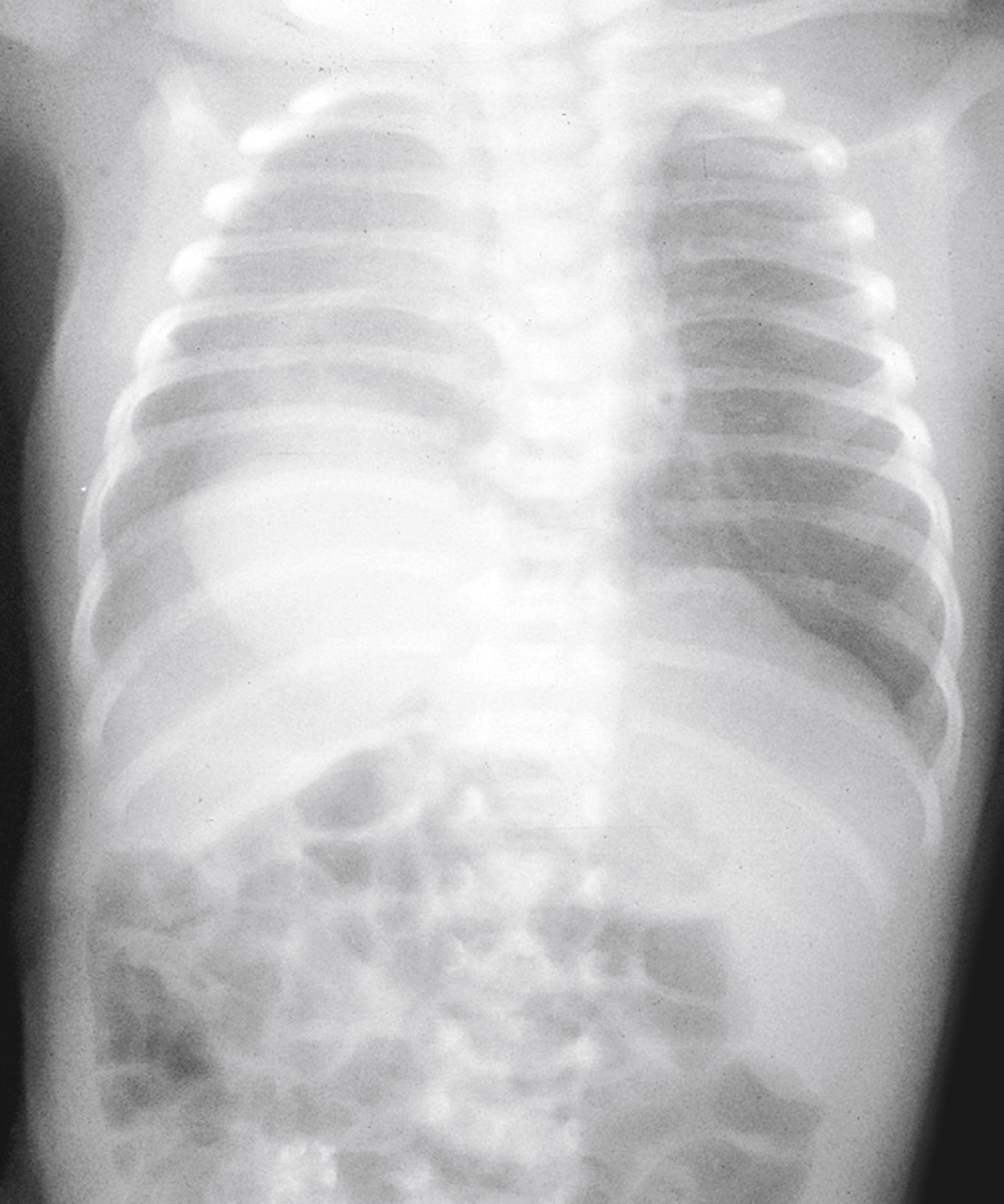

Become a Clinical Tree membership for Full access and enjoy Unlimited articles
If you are a member. Log in here